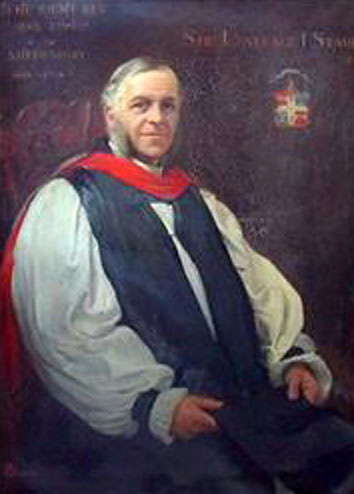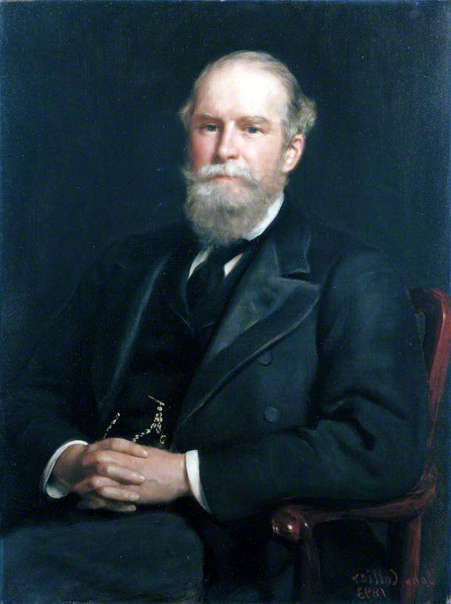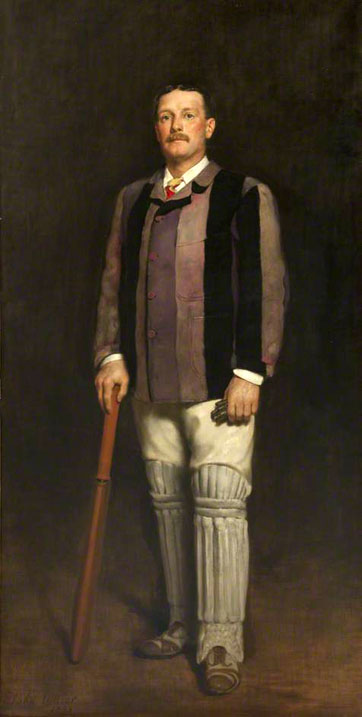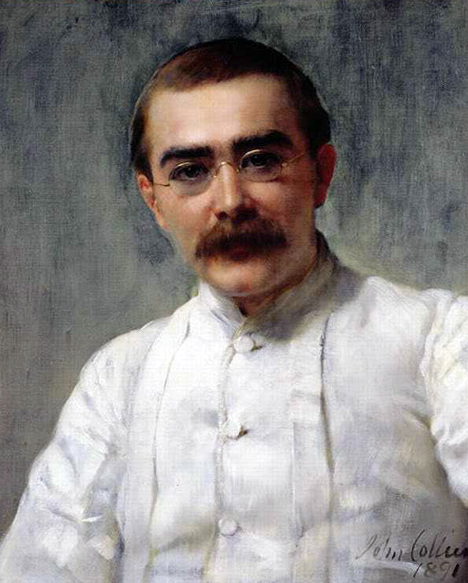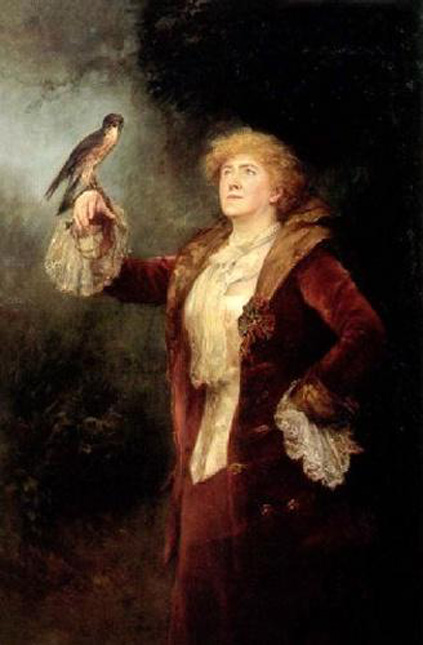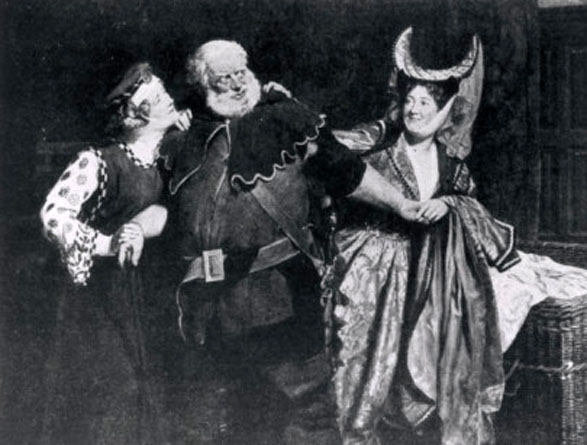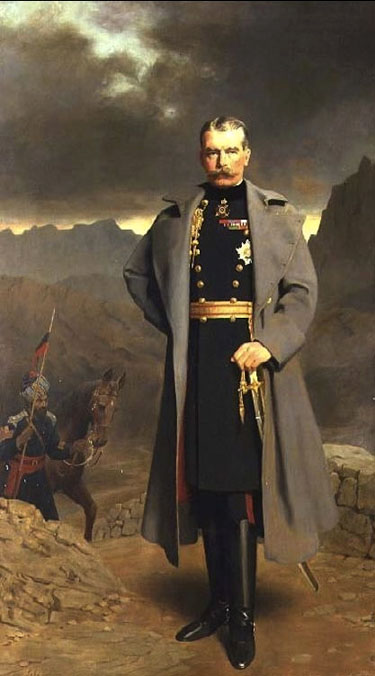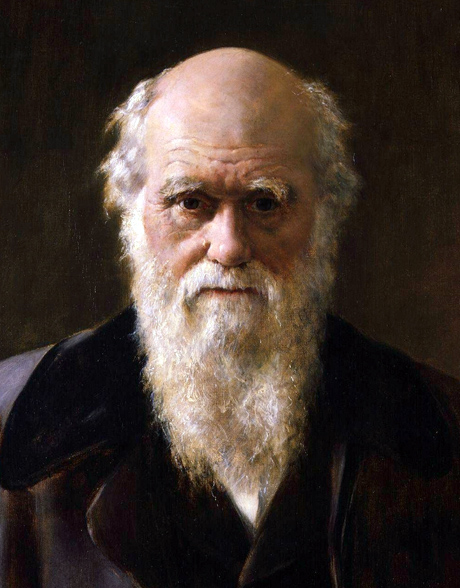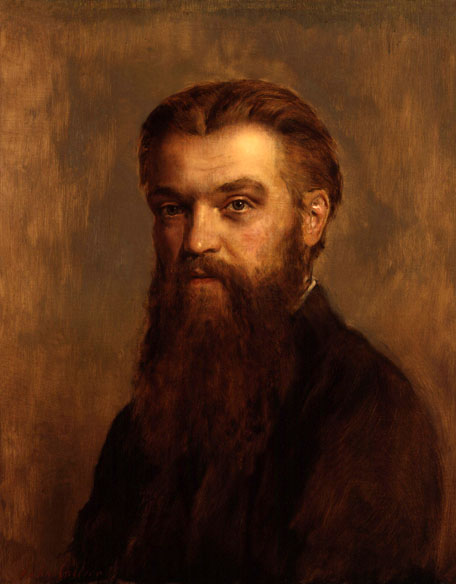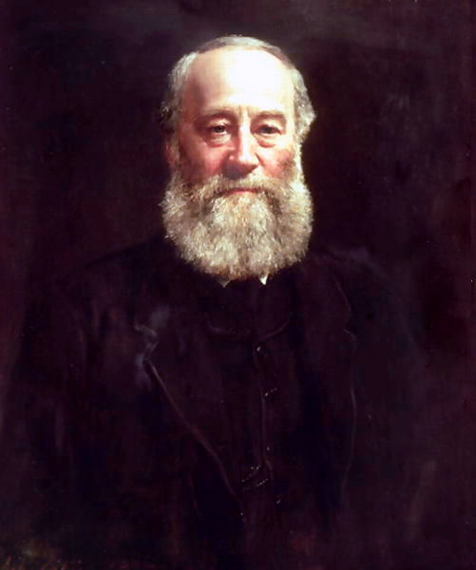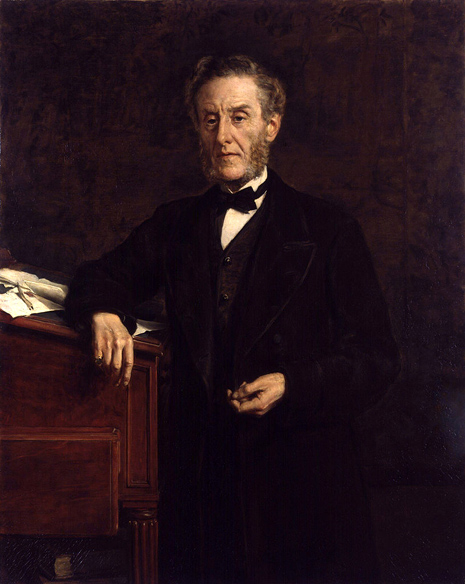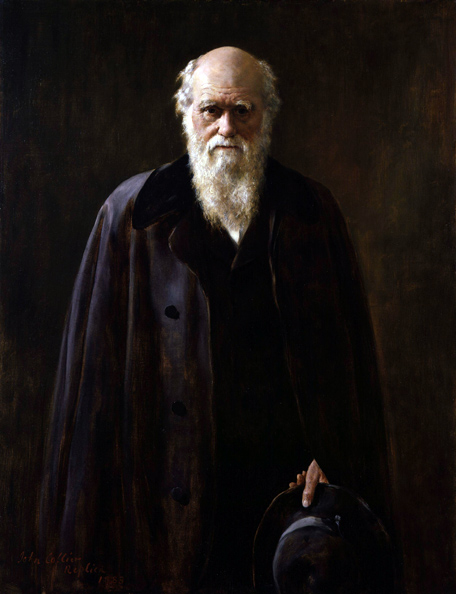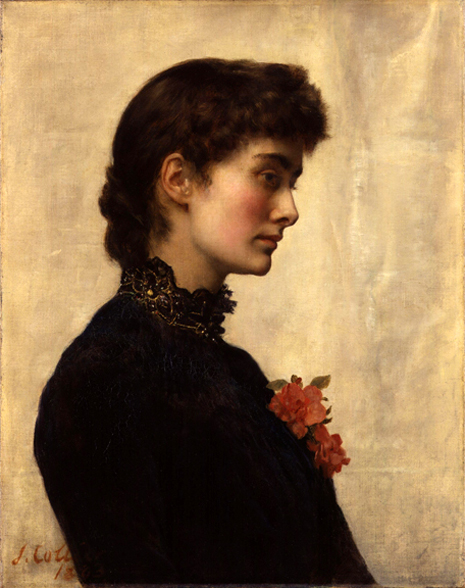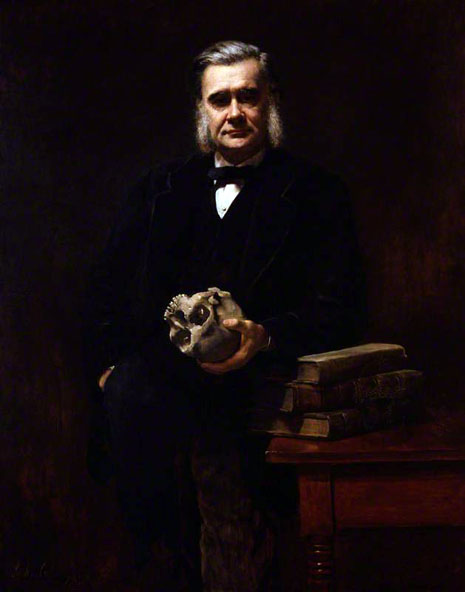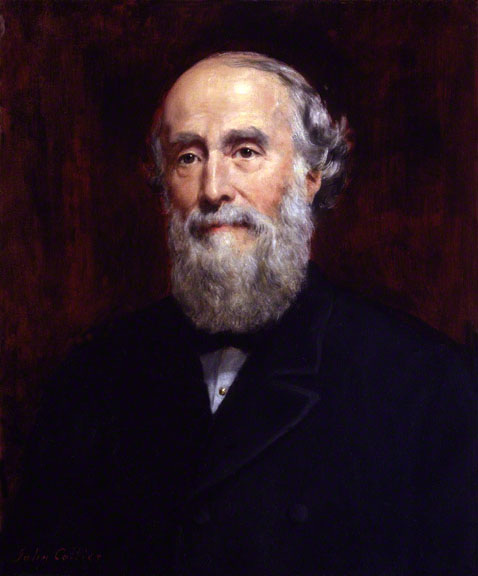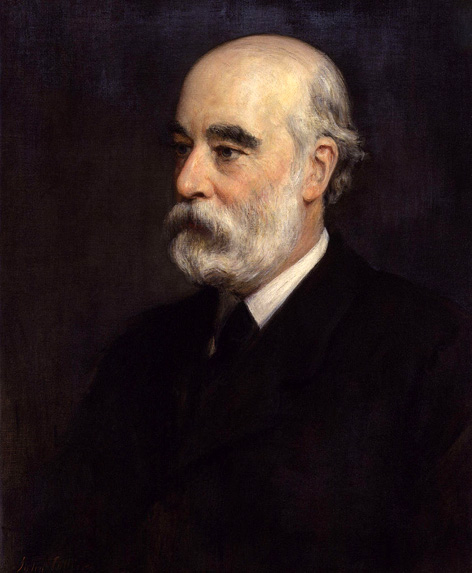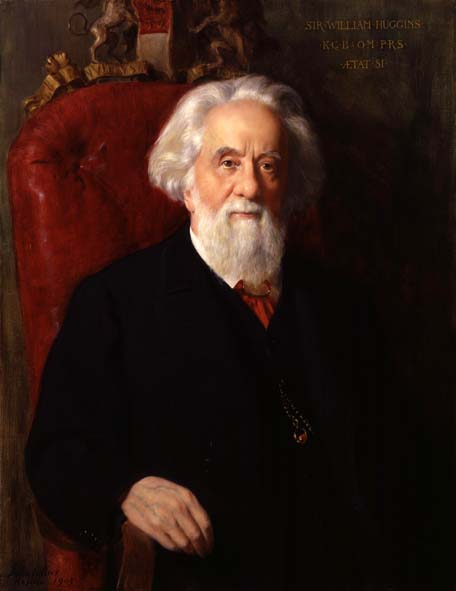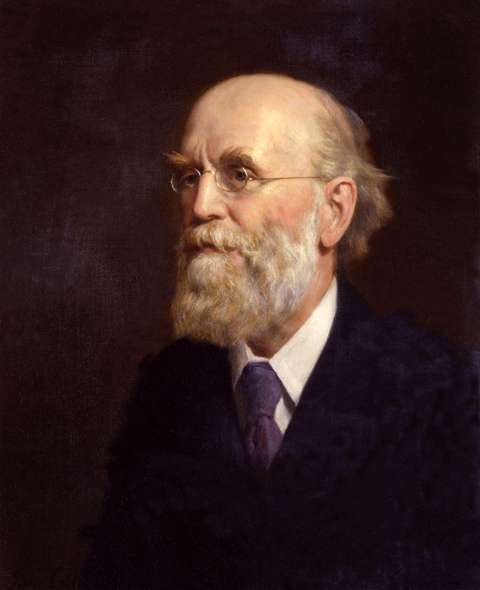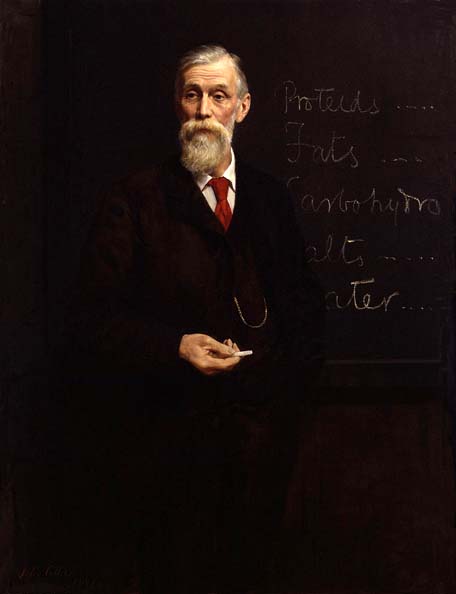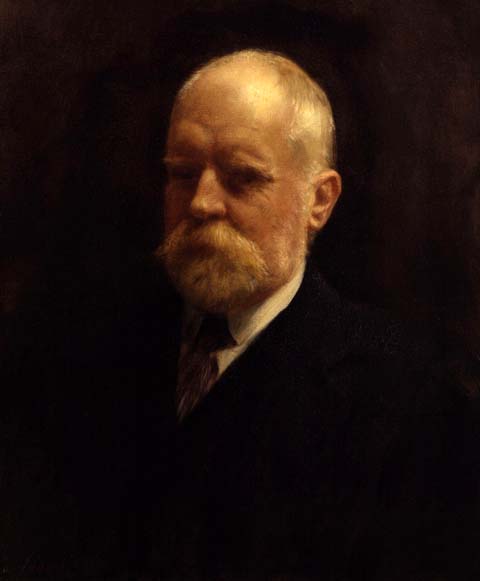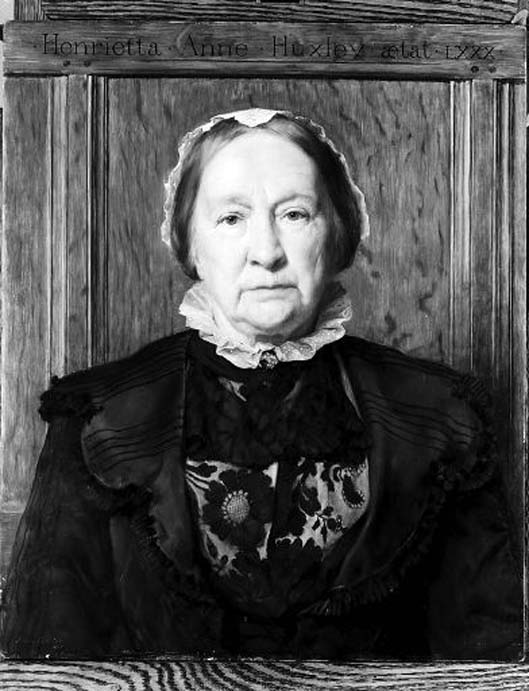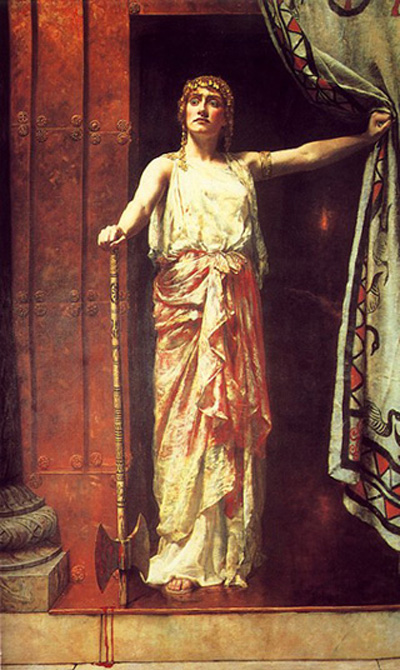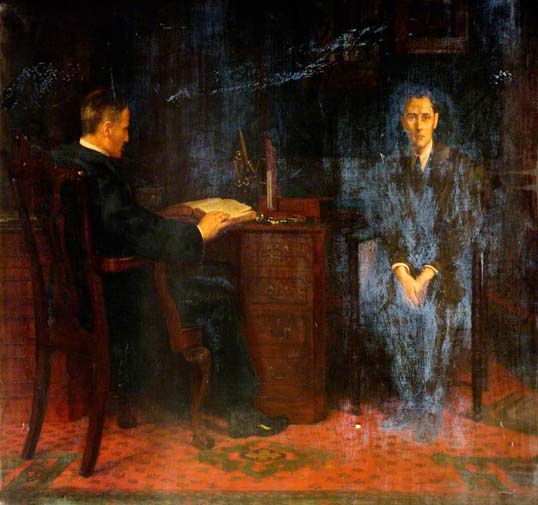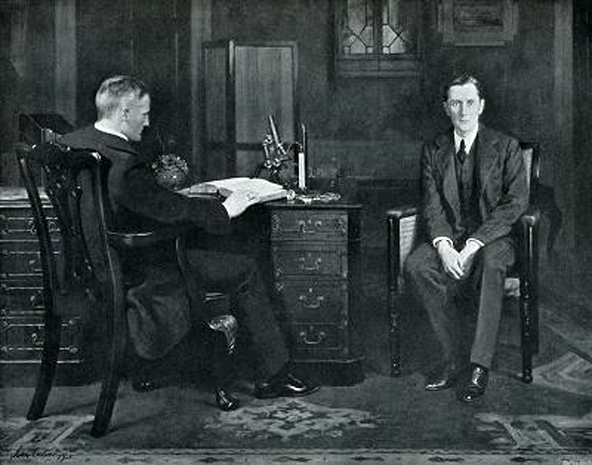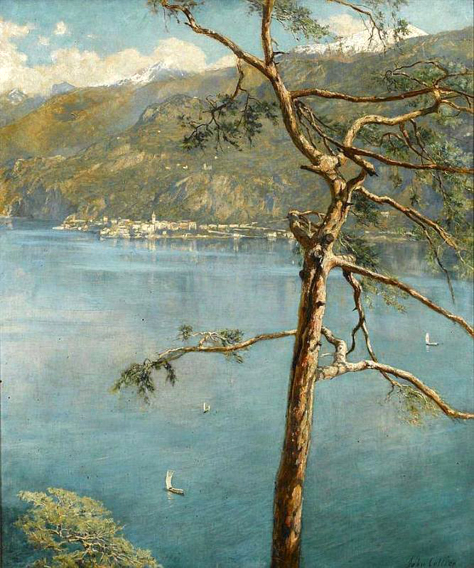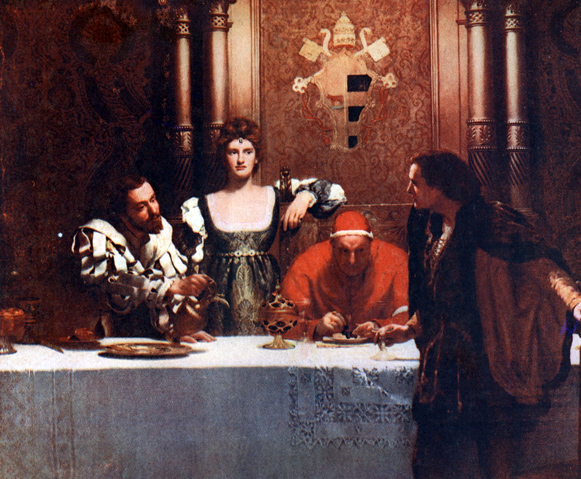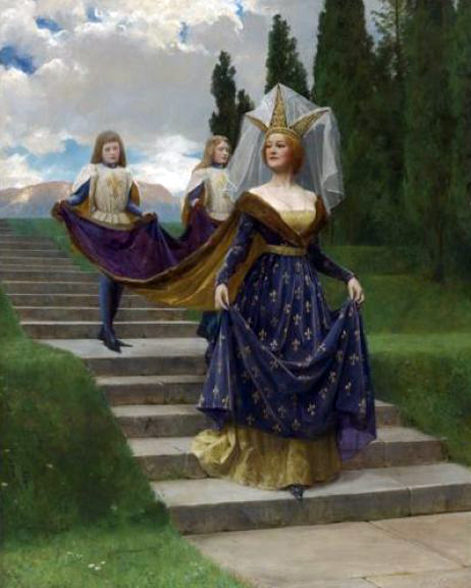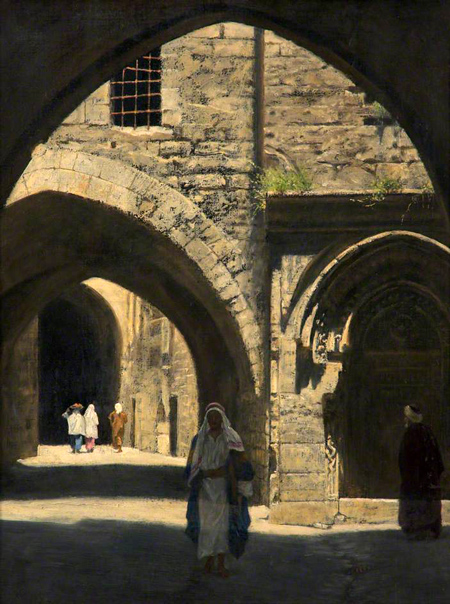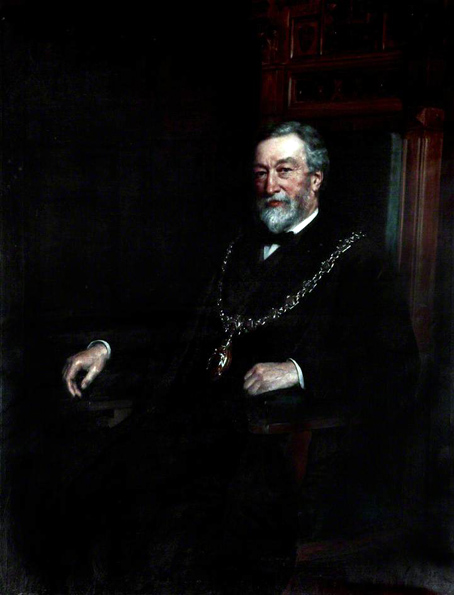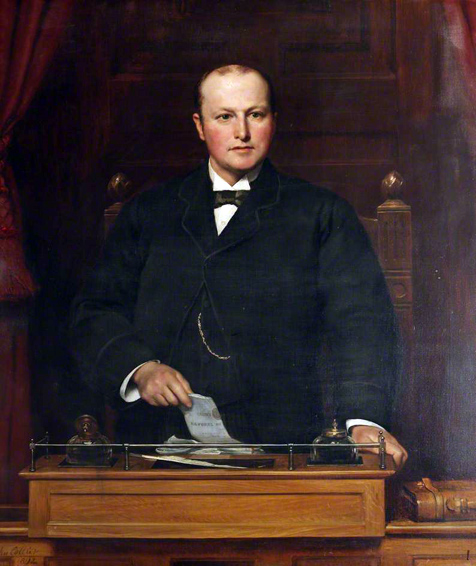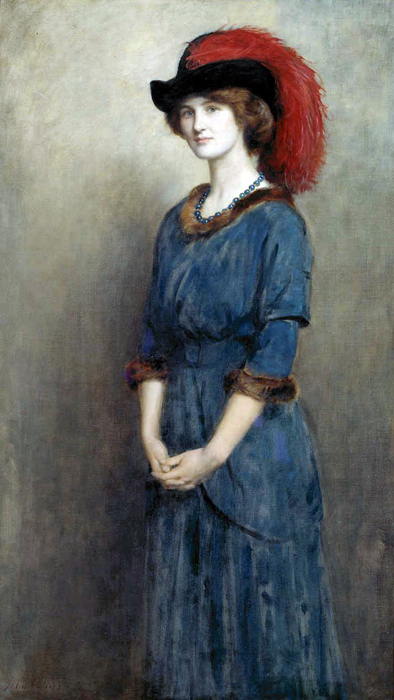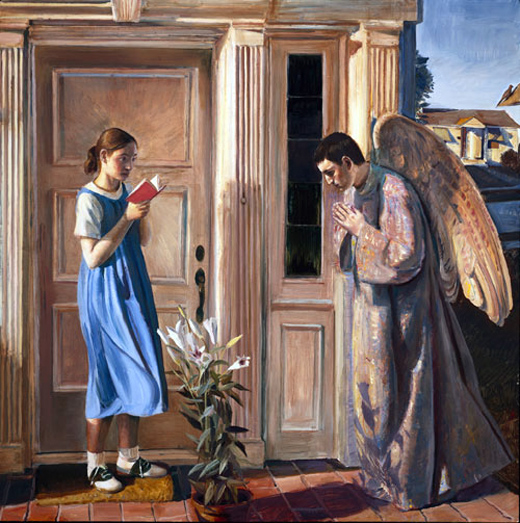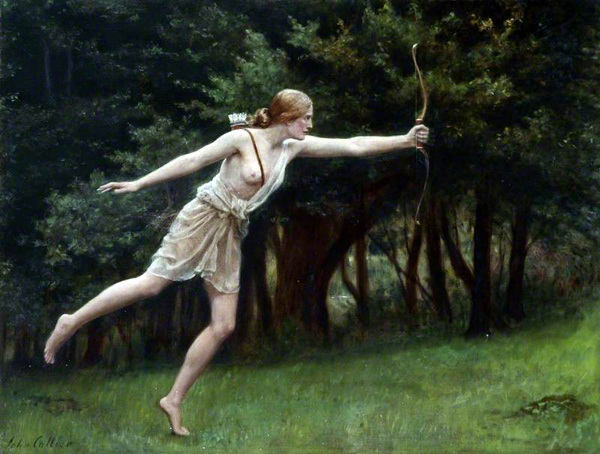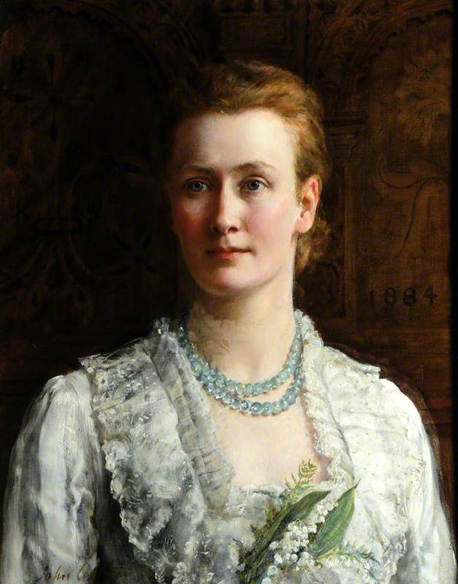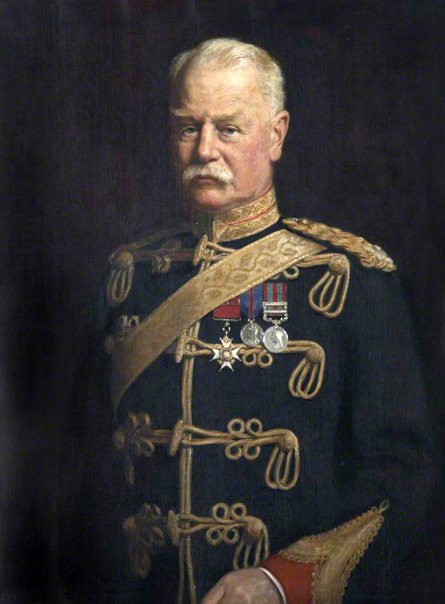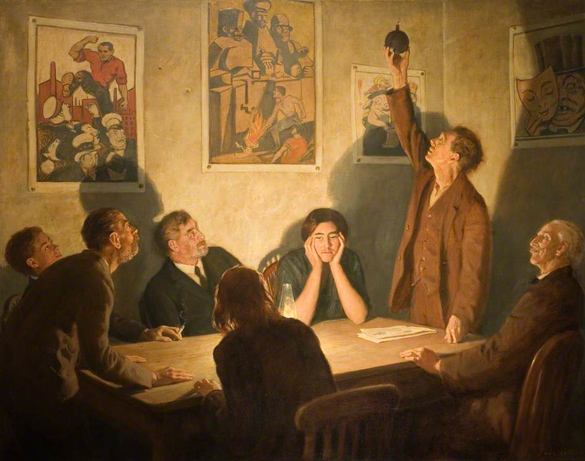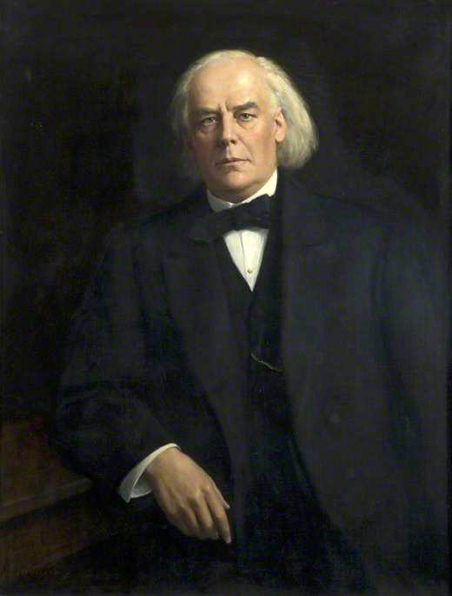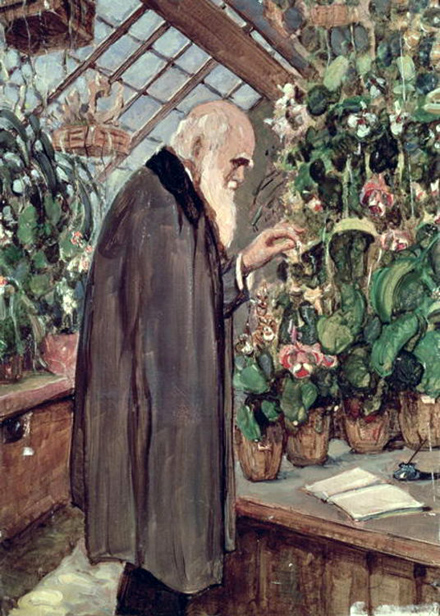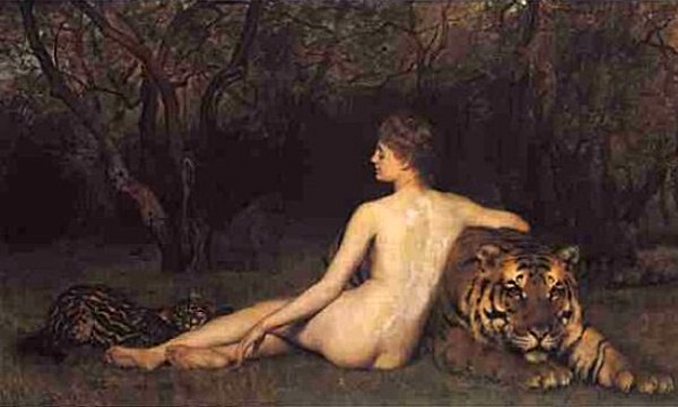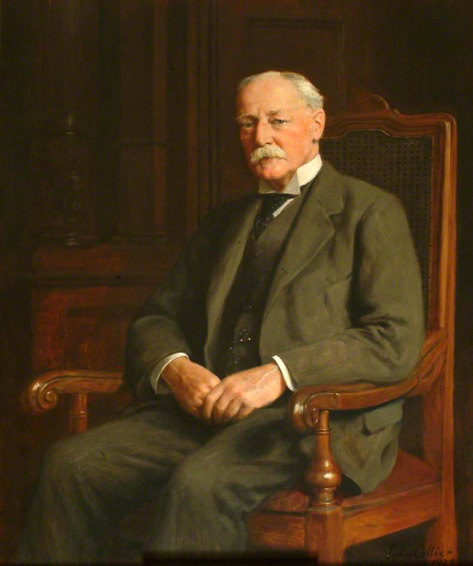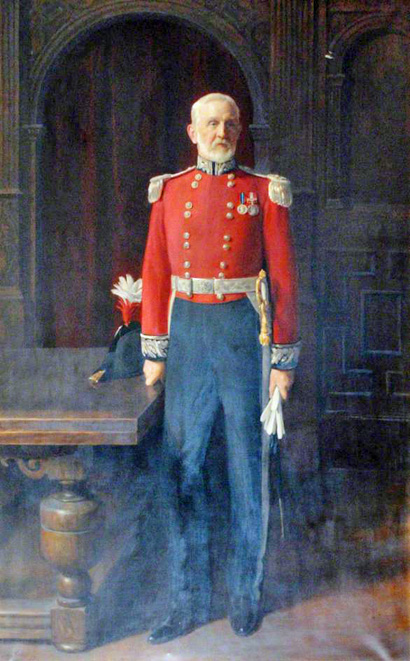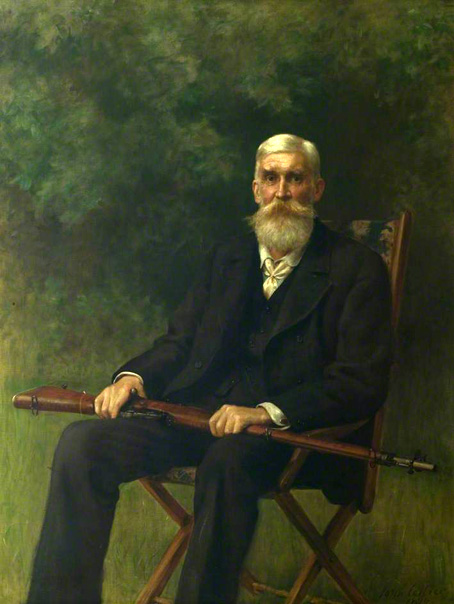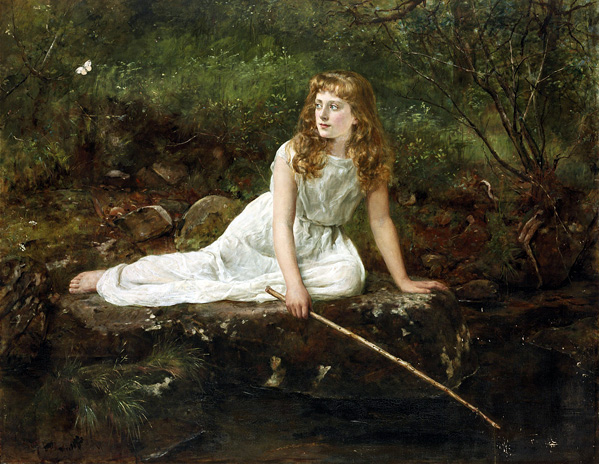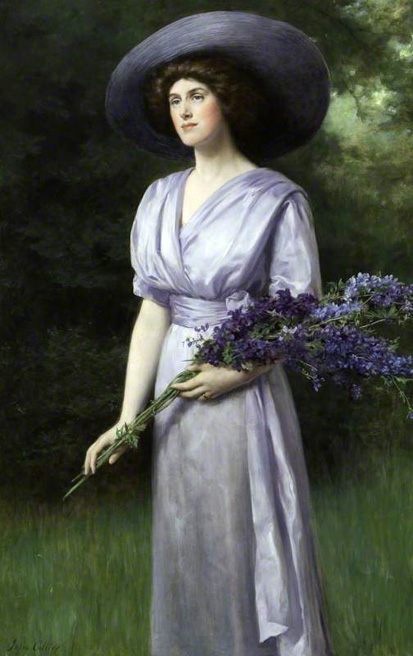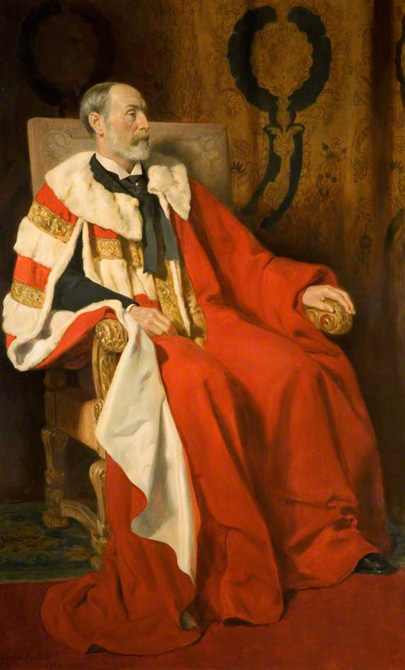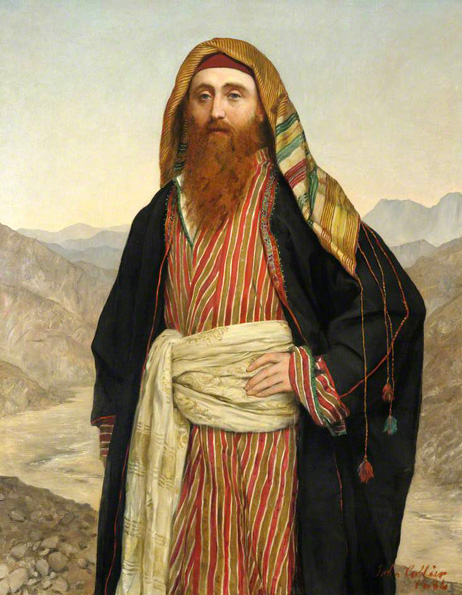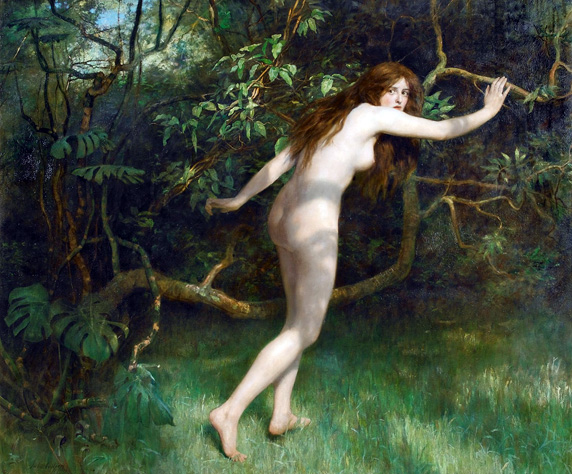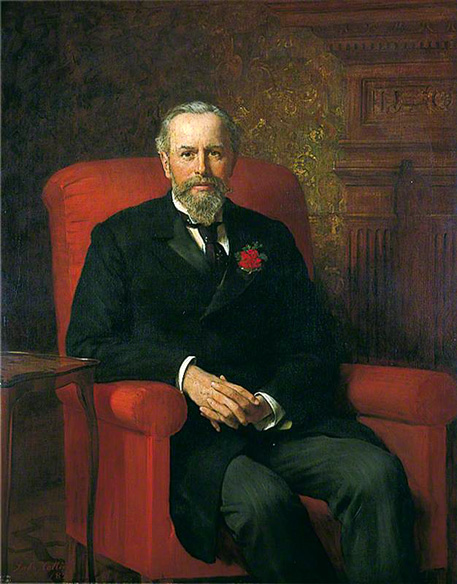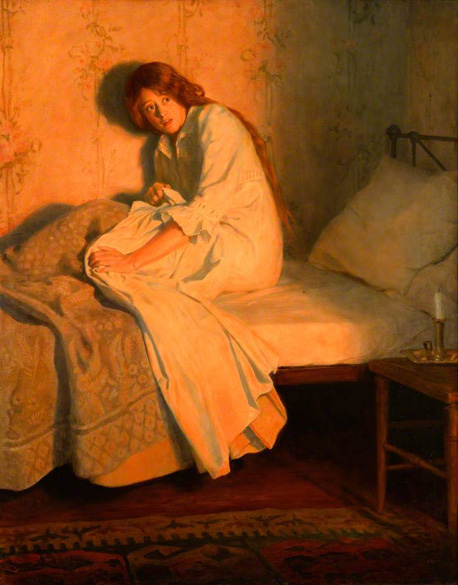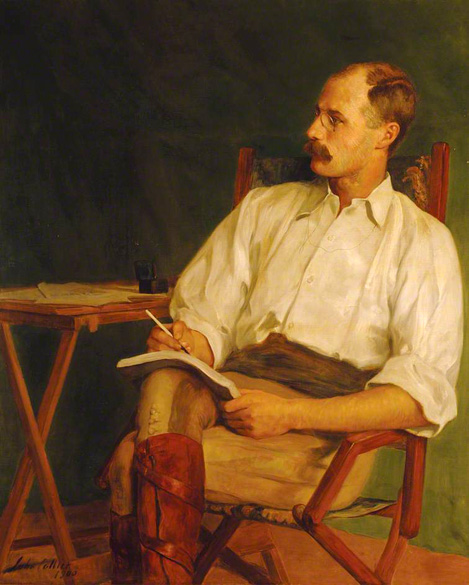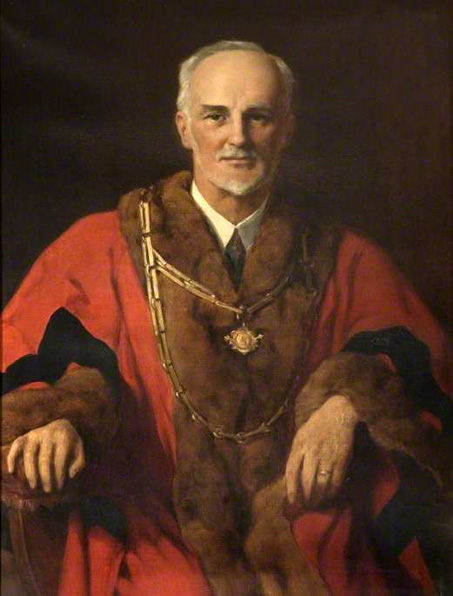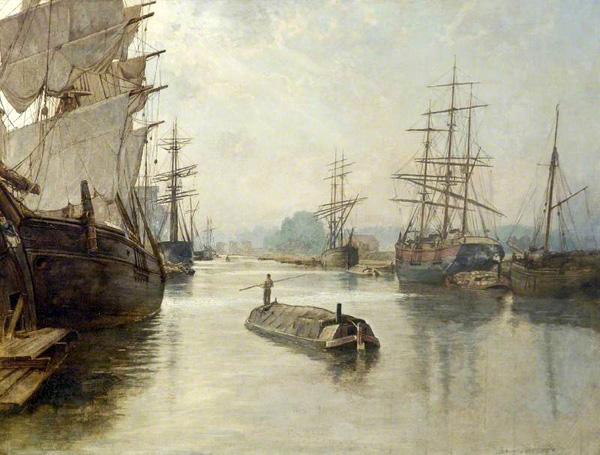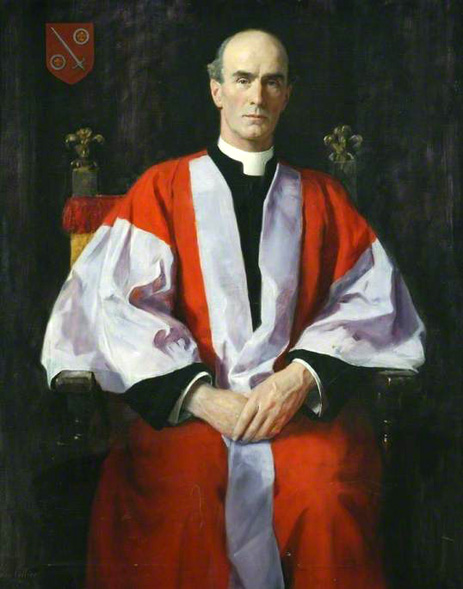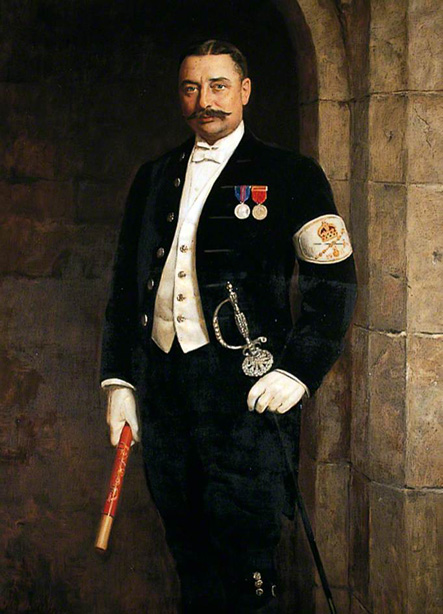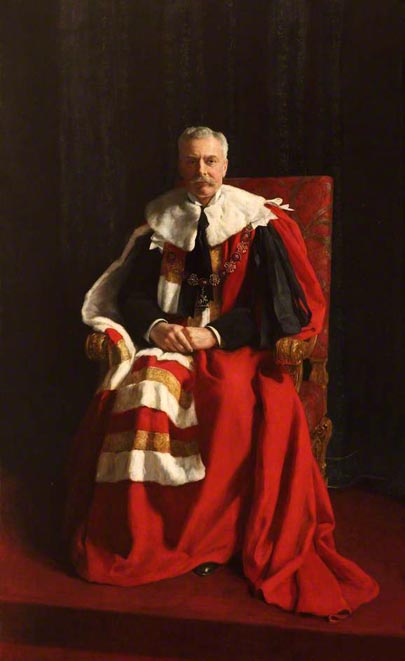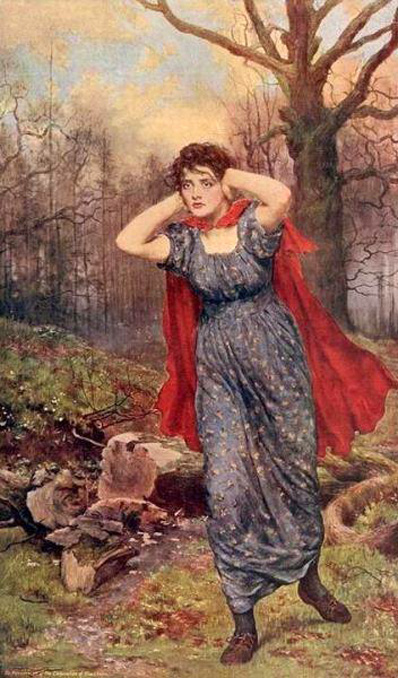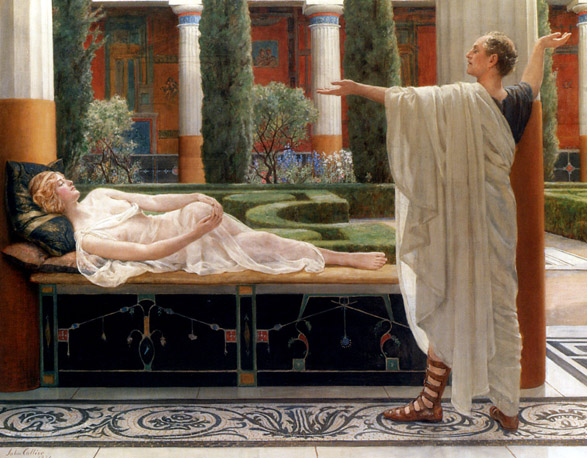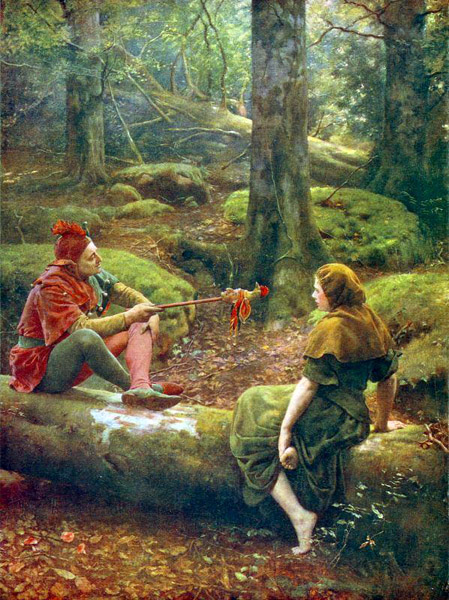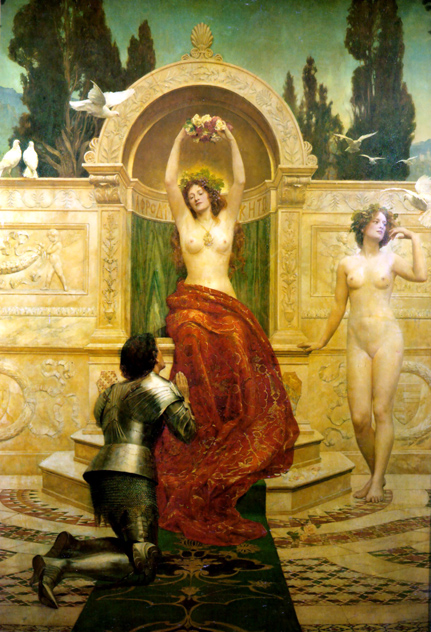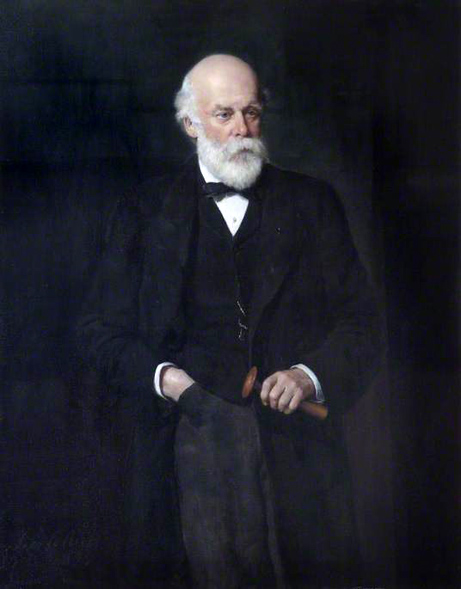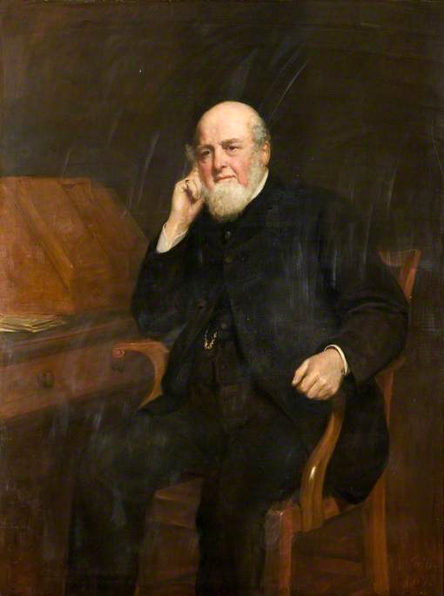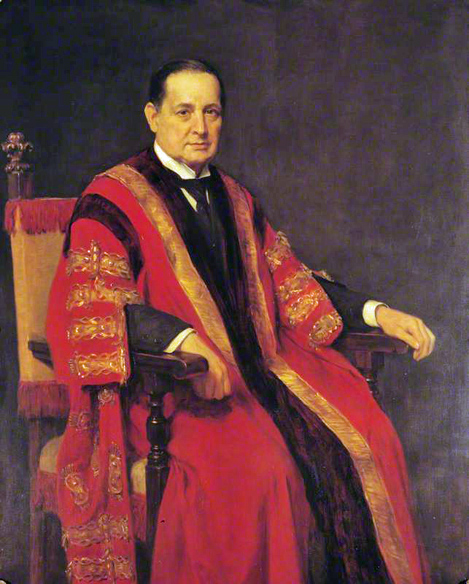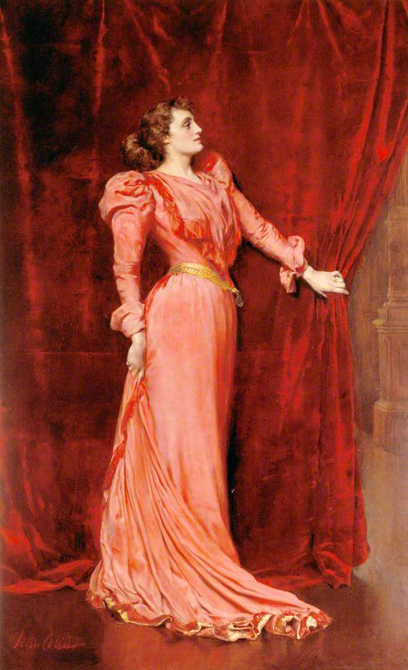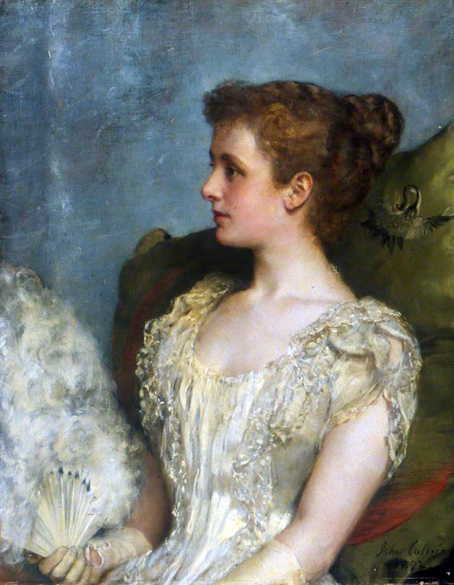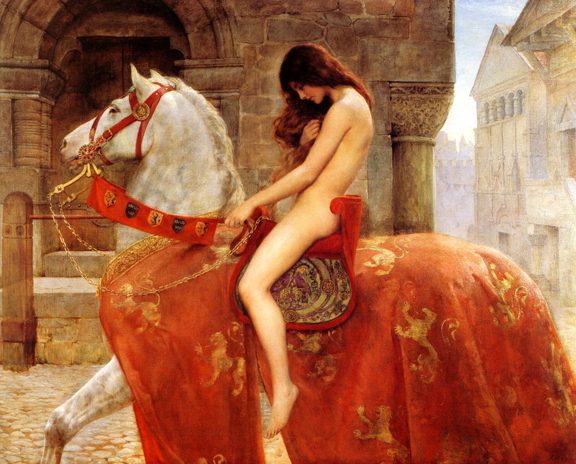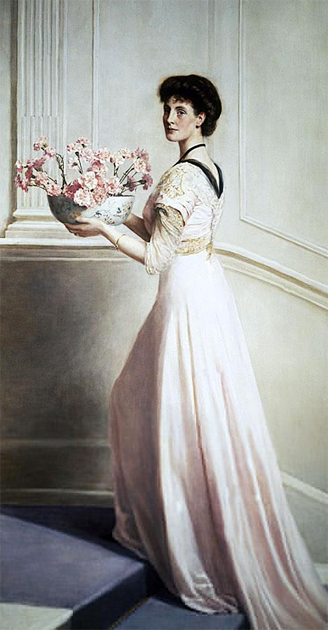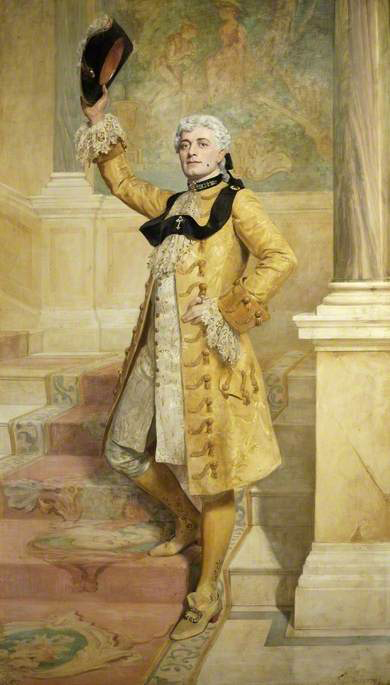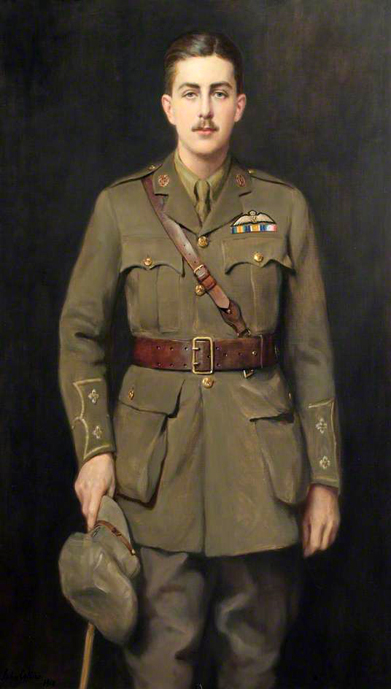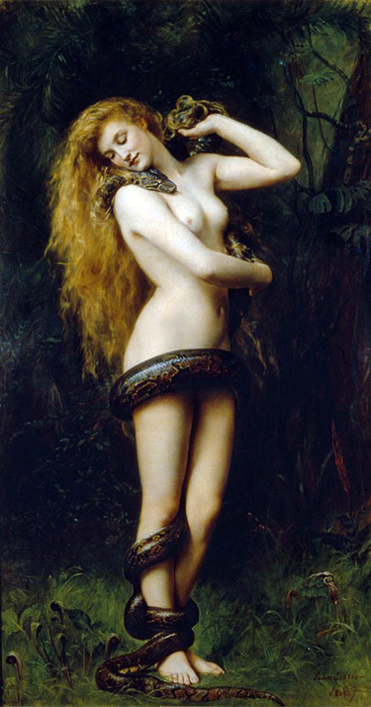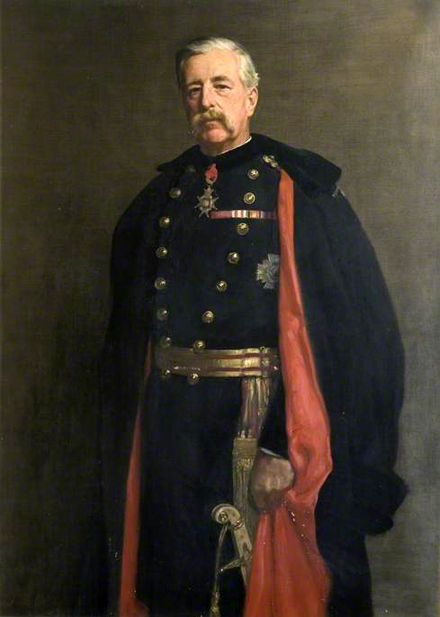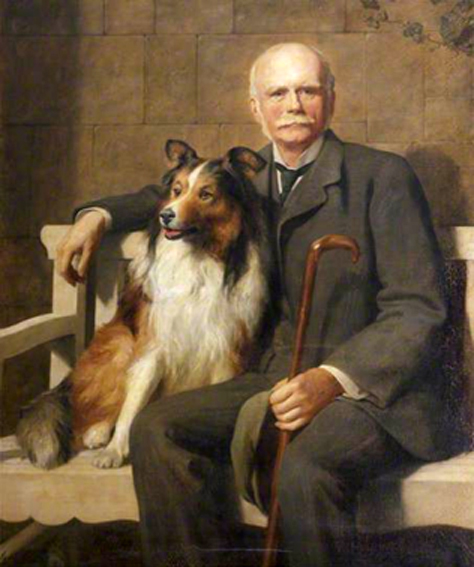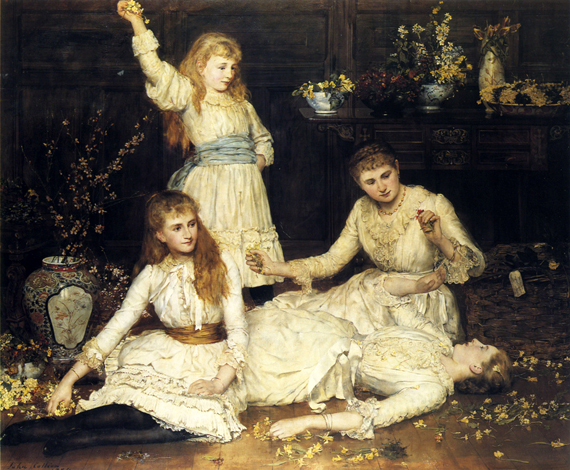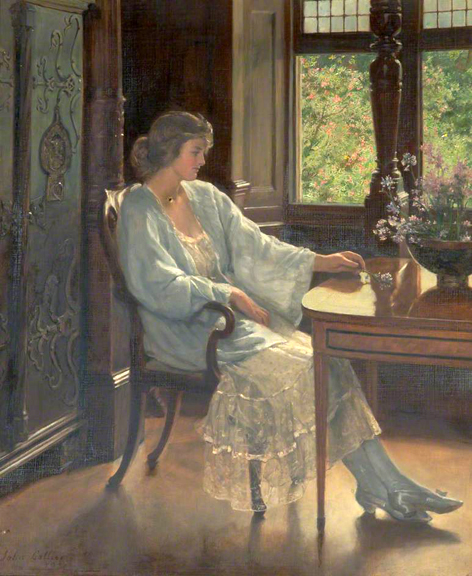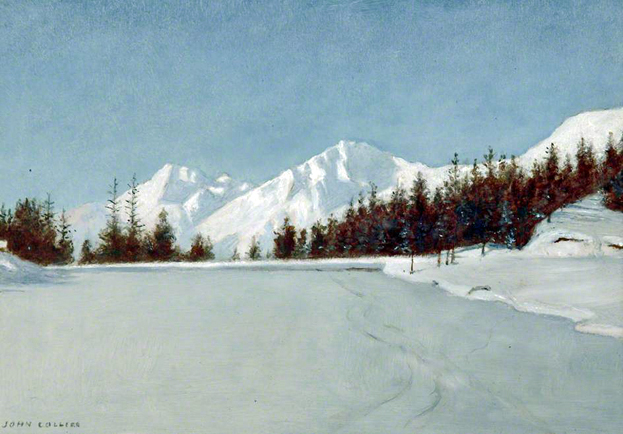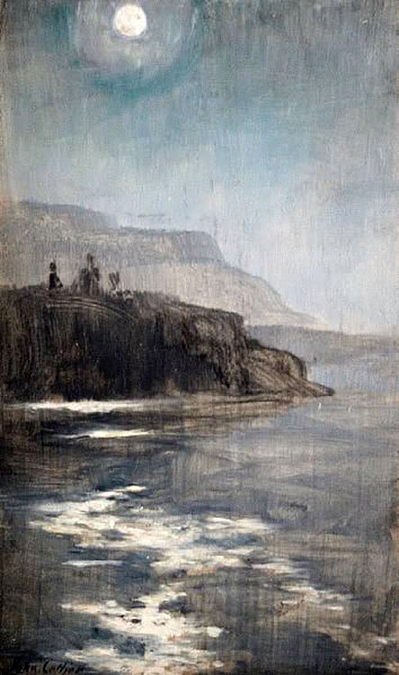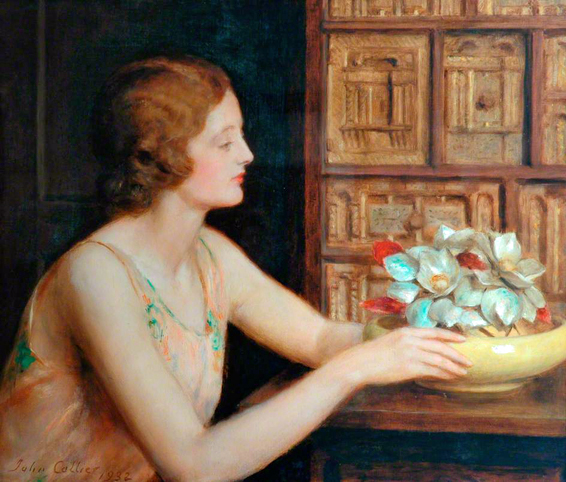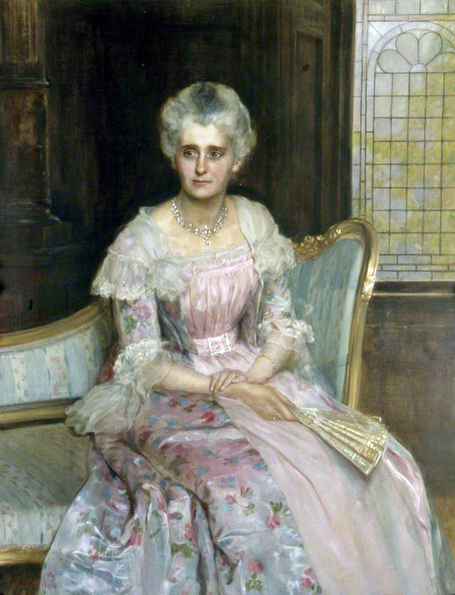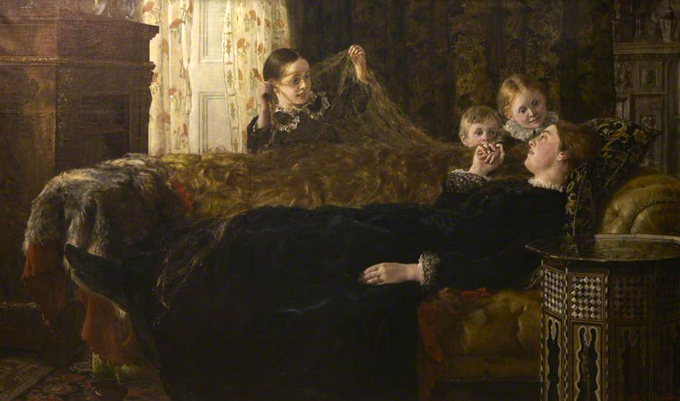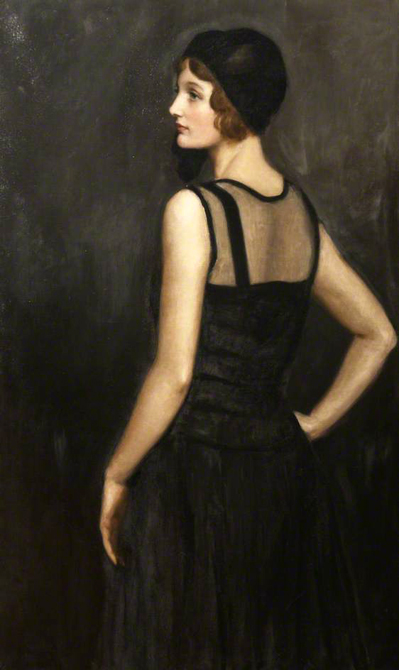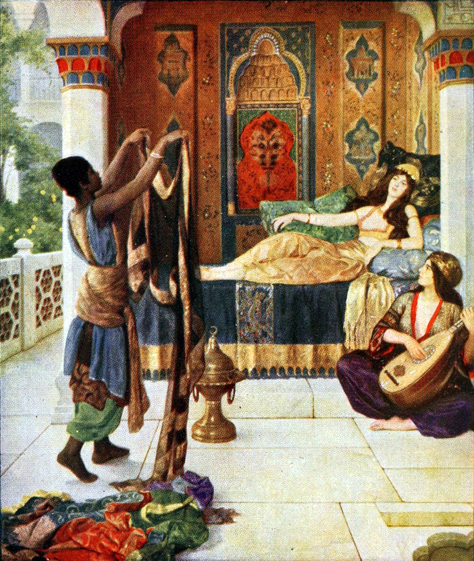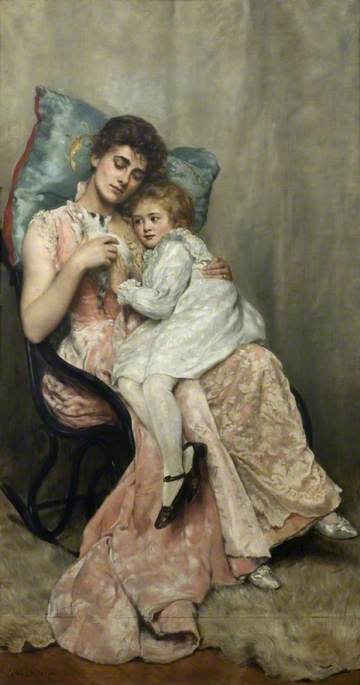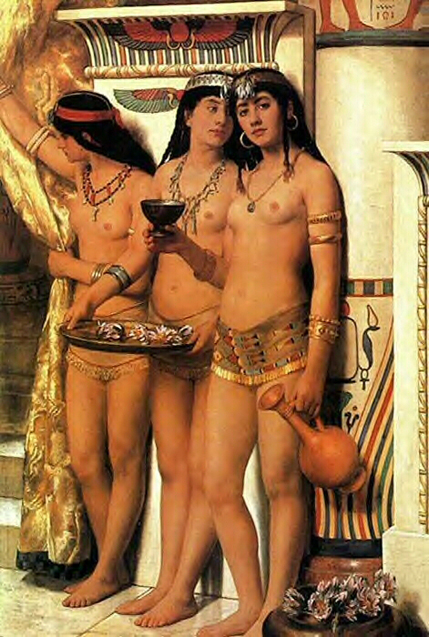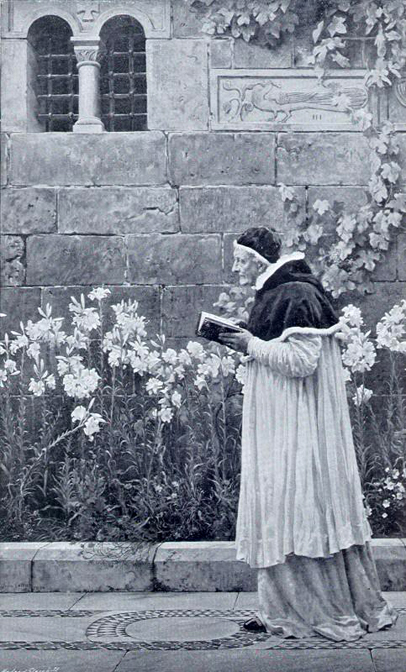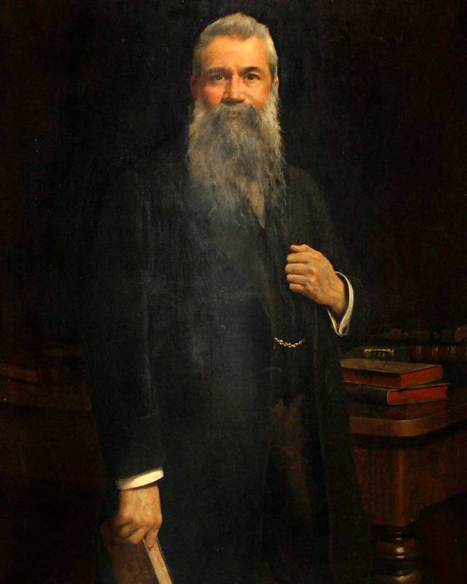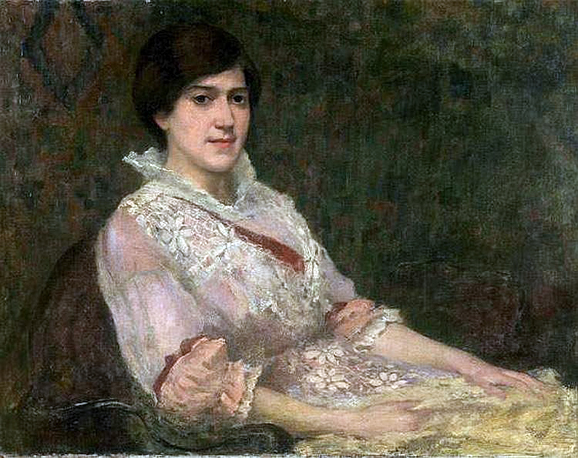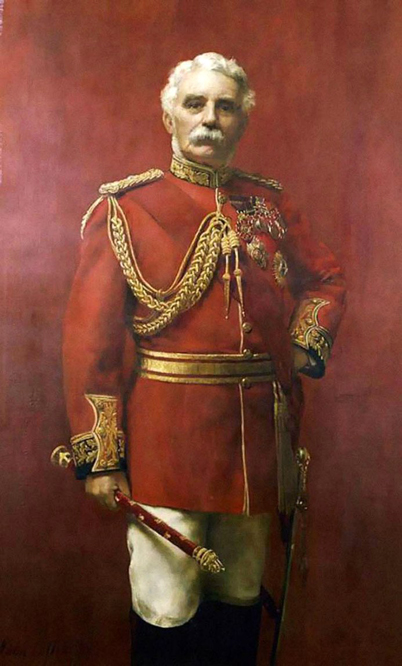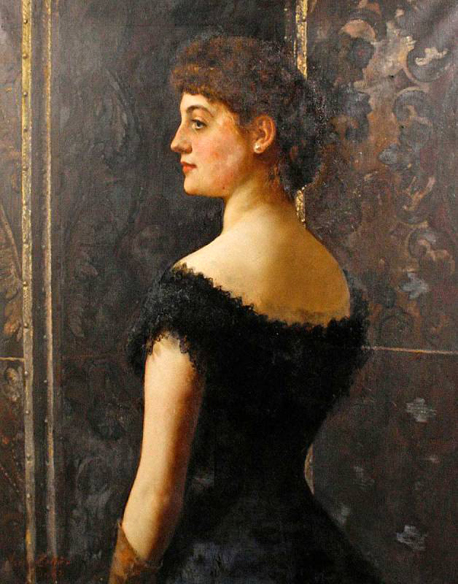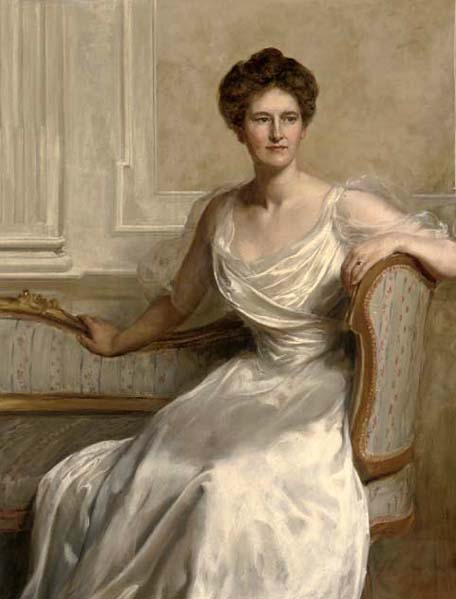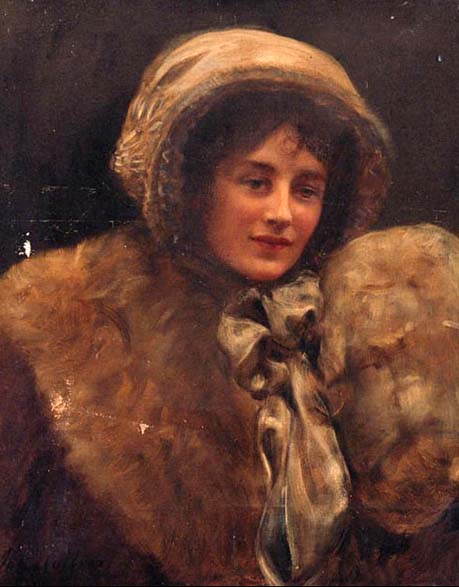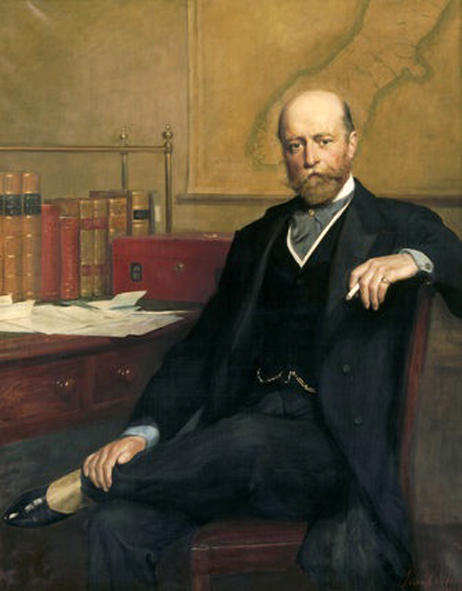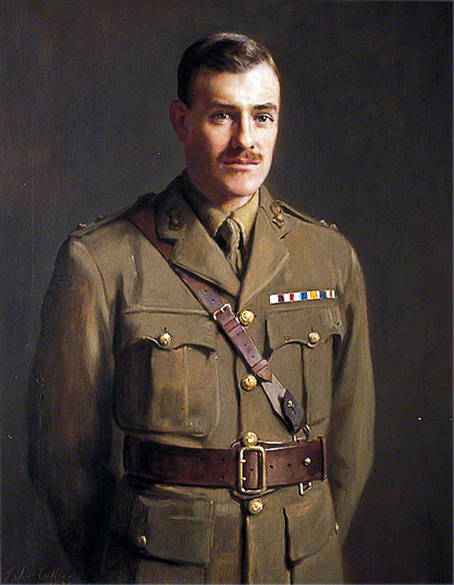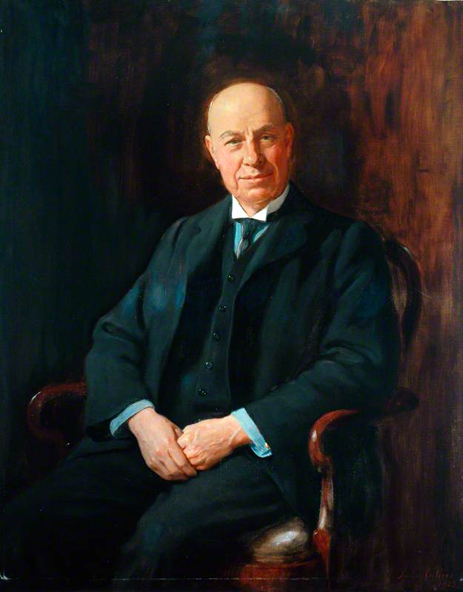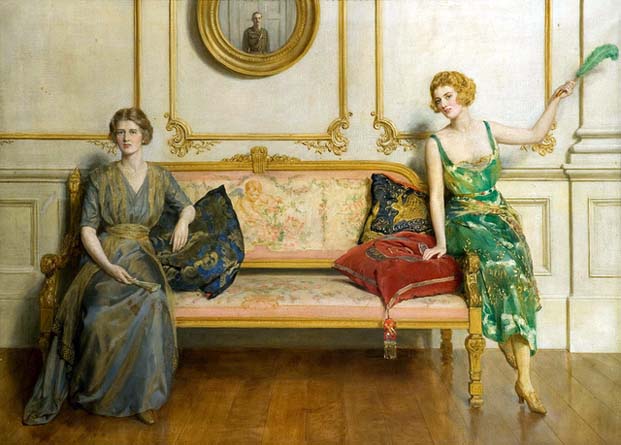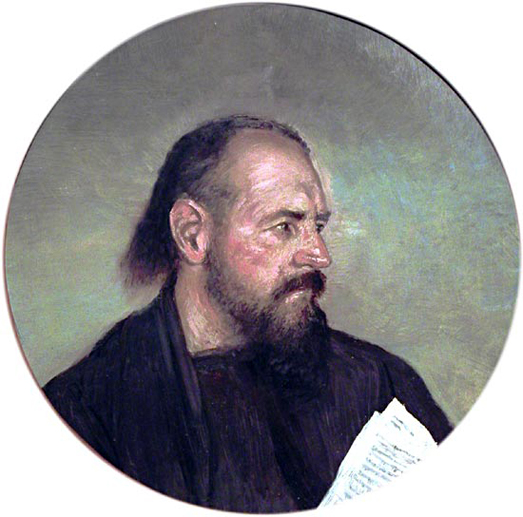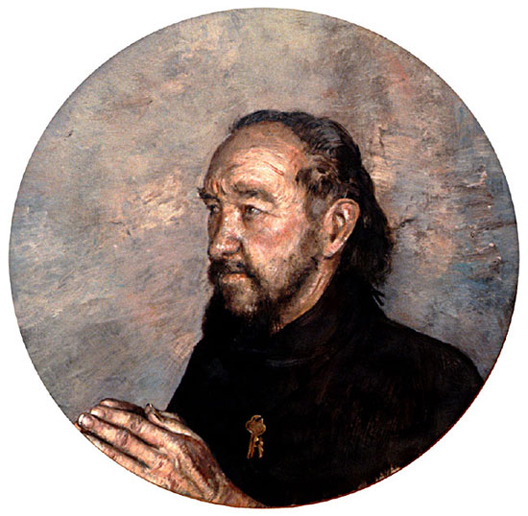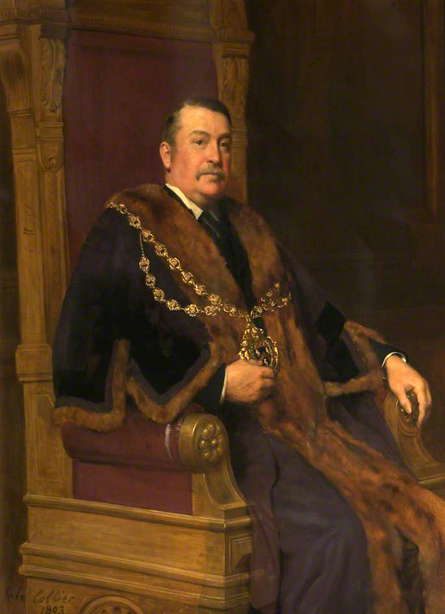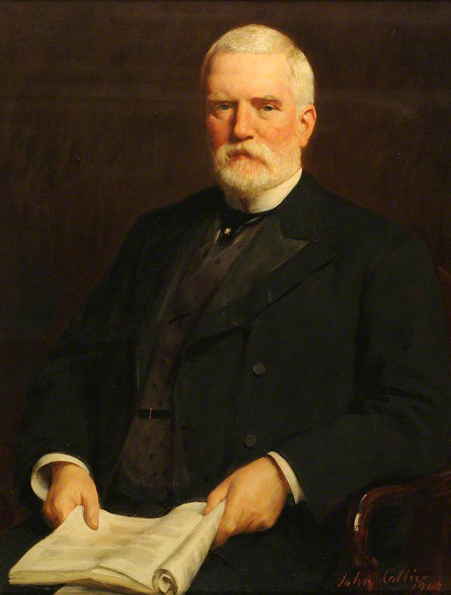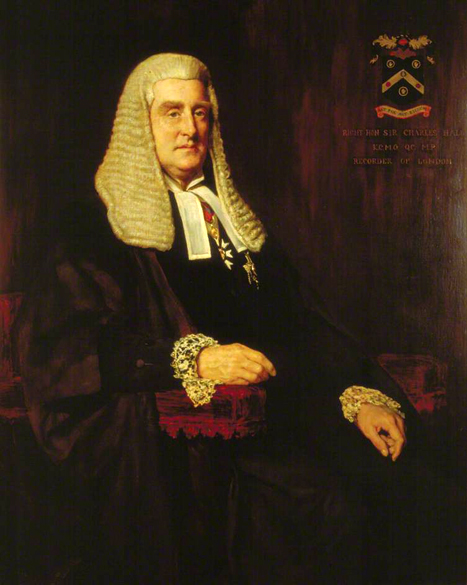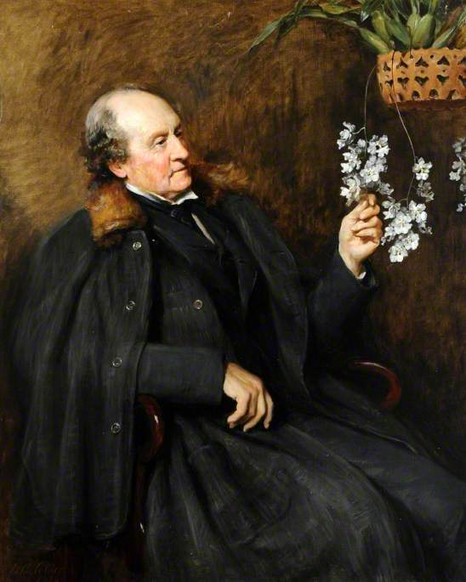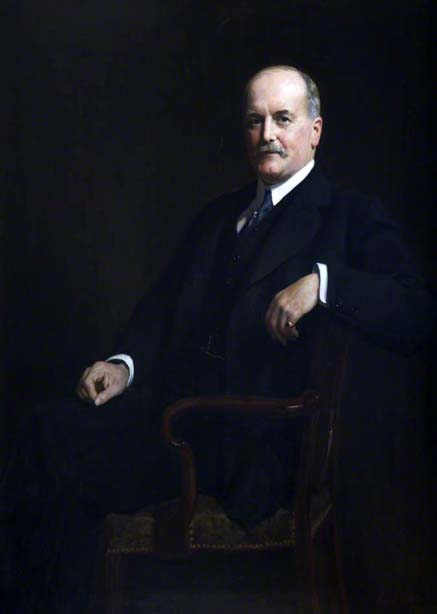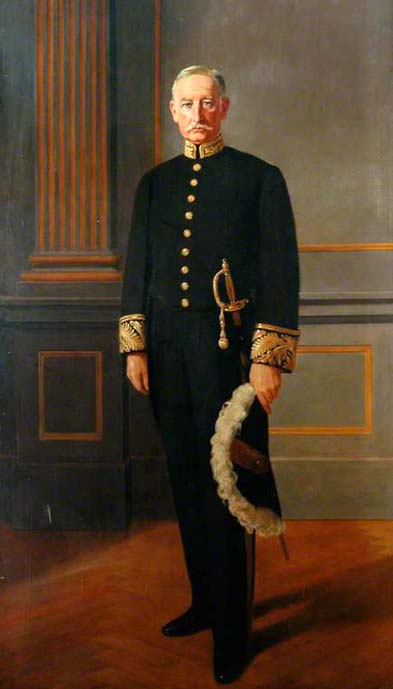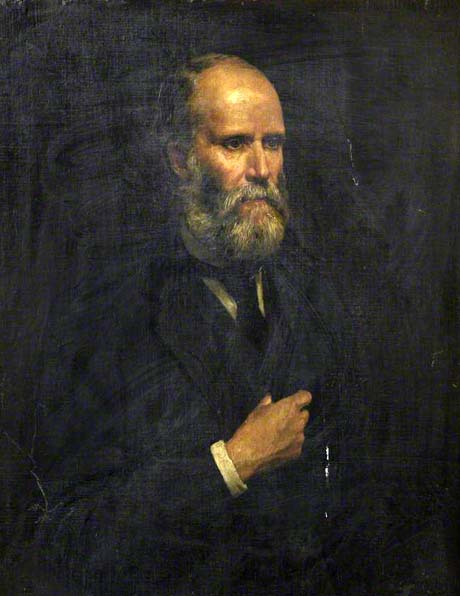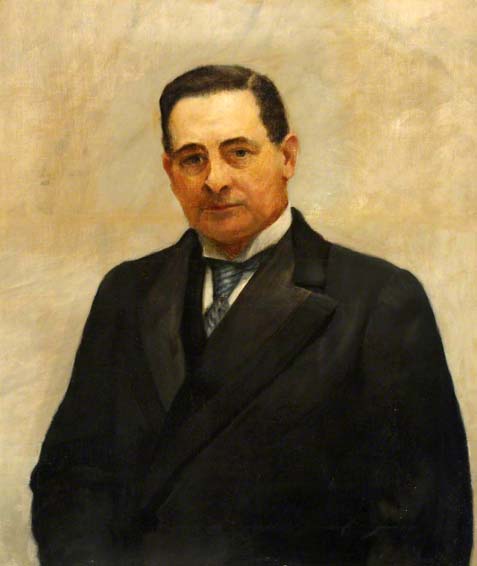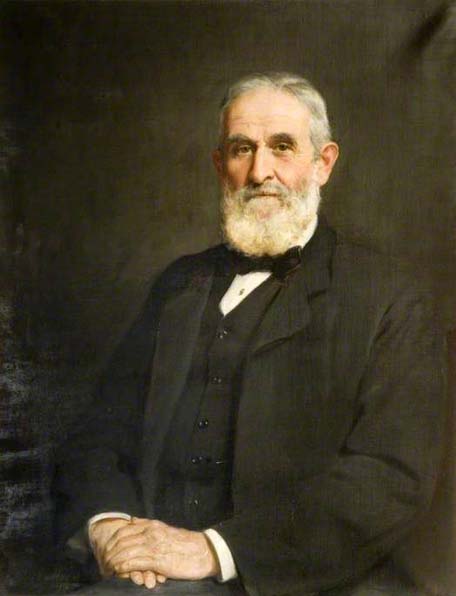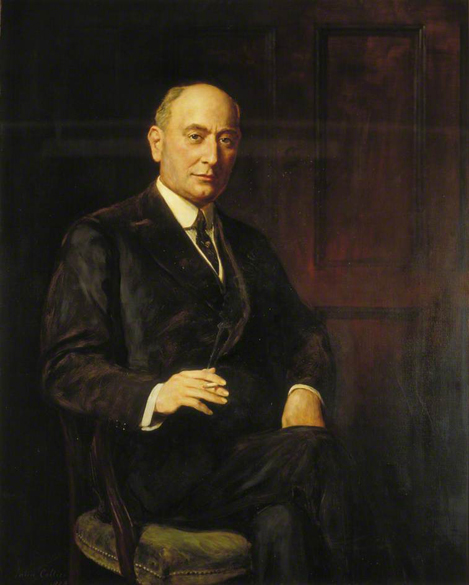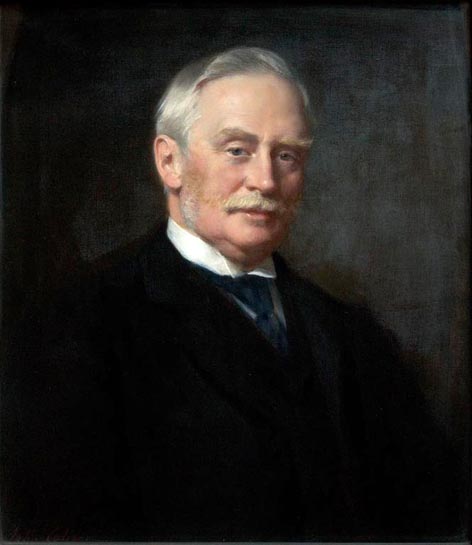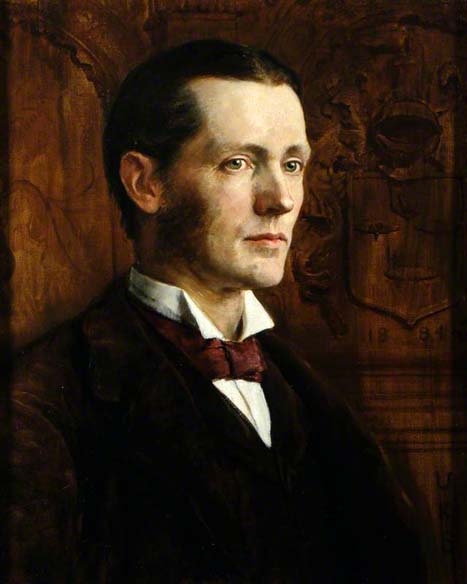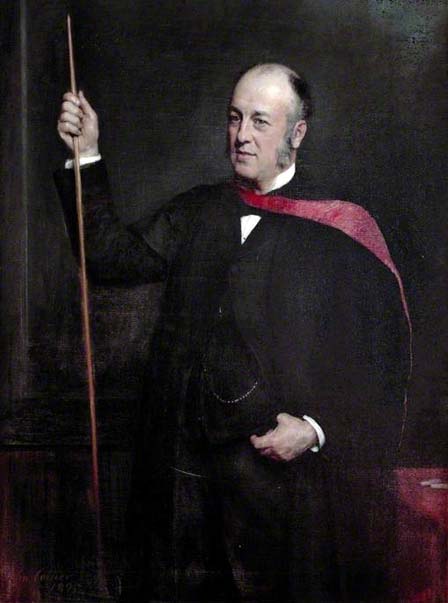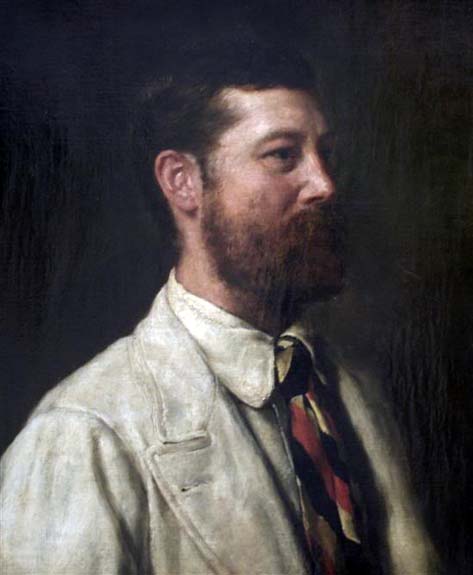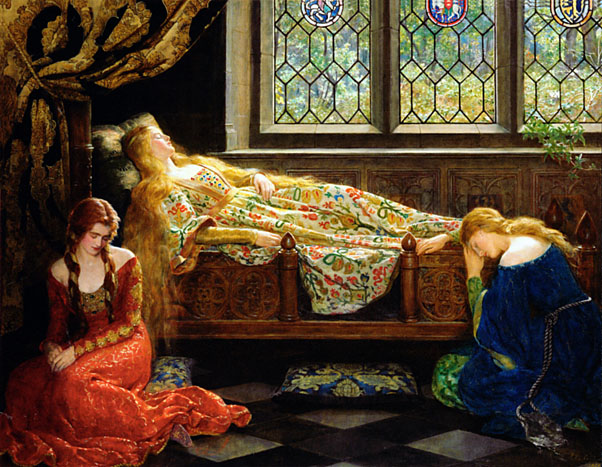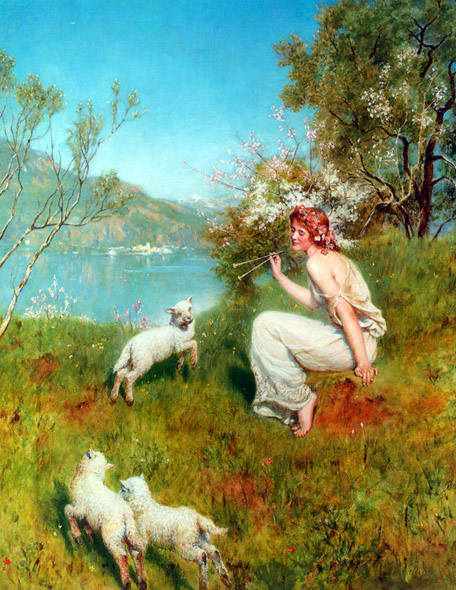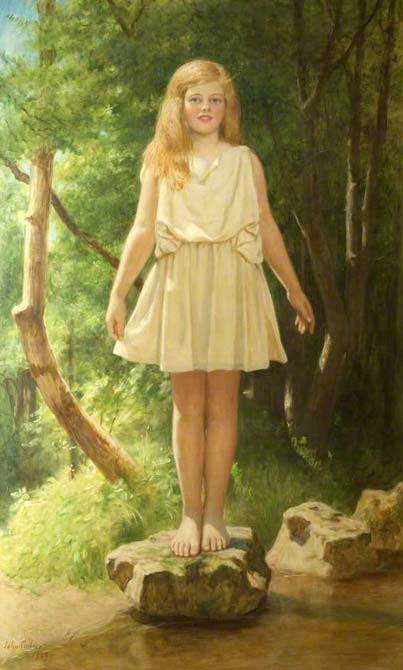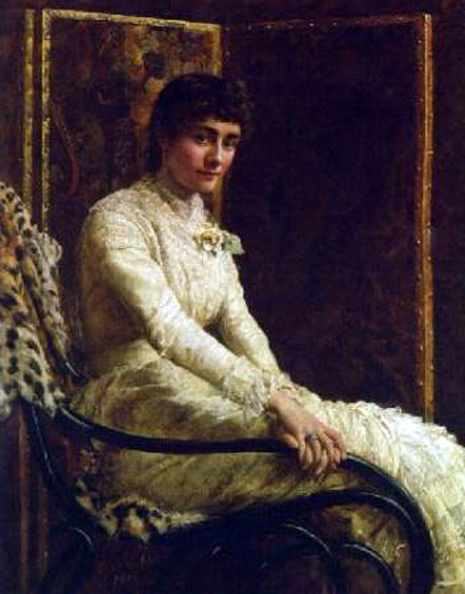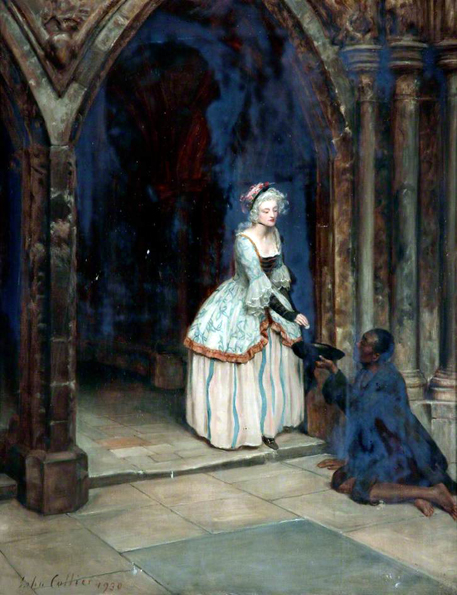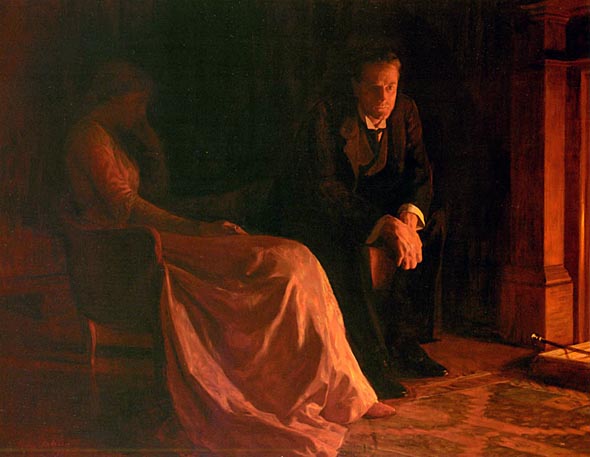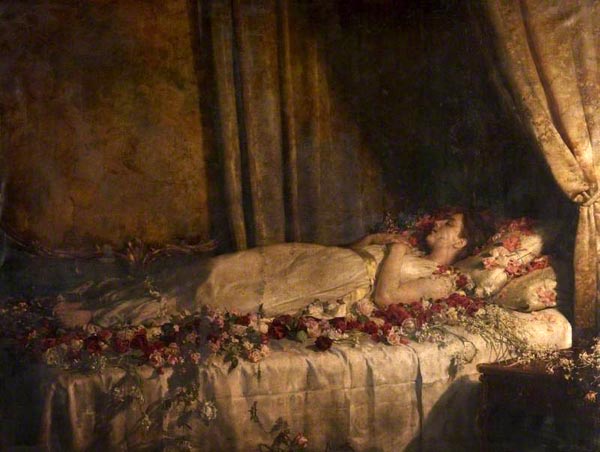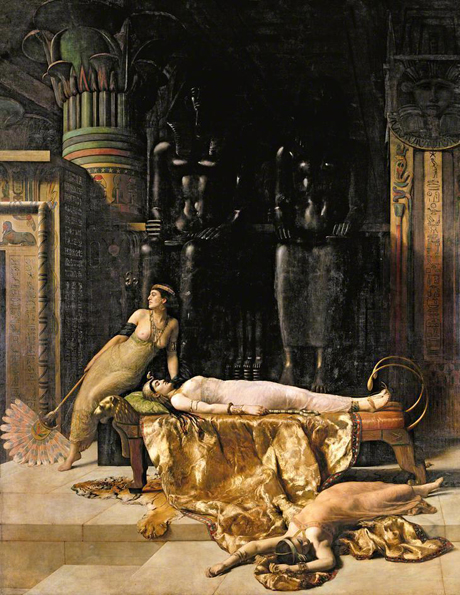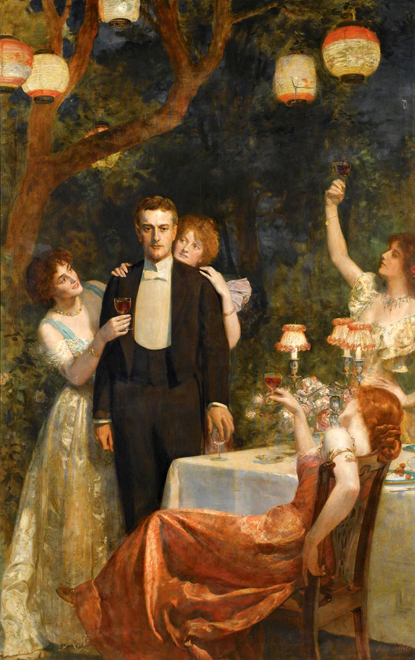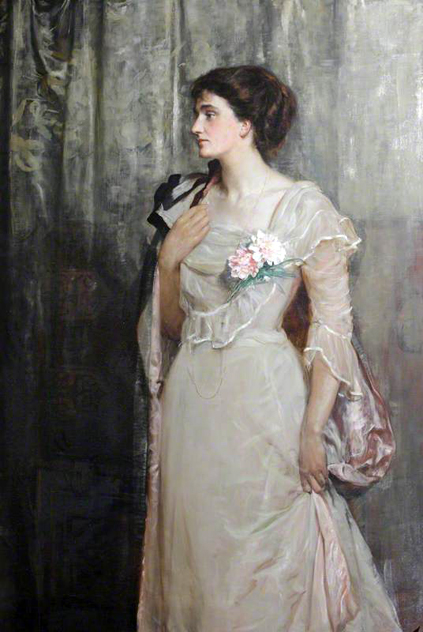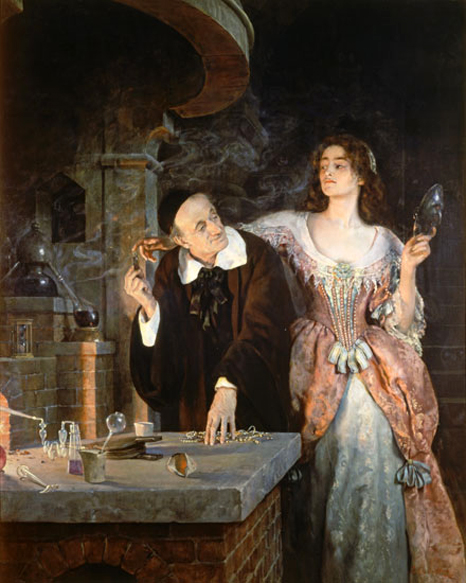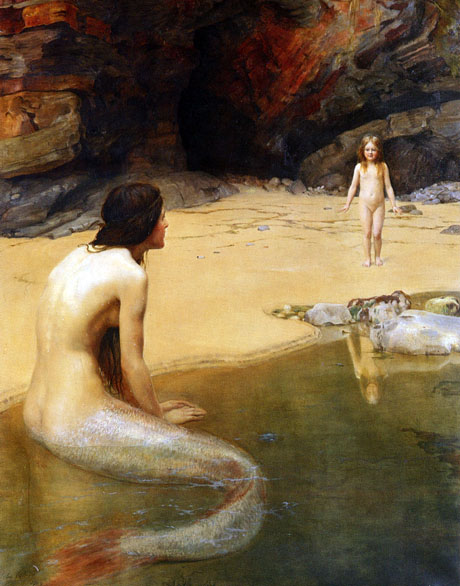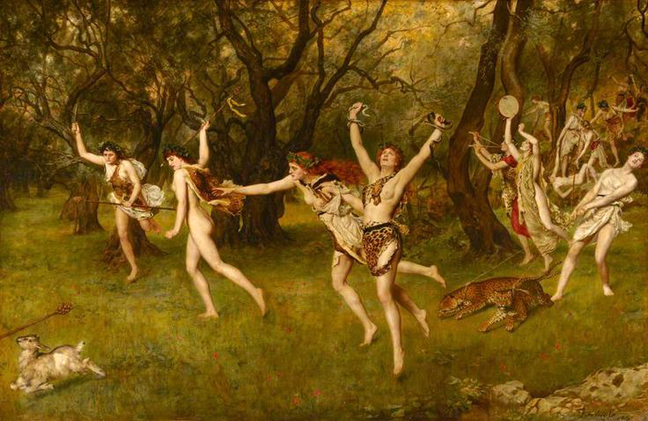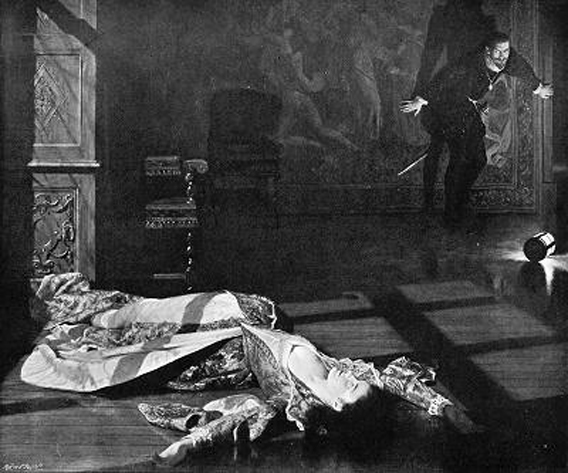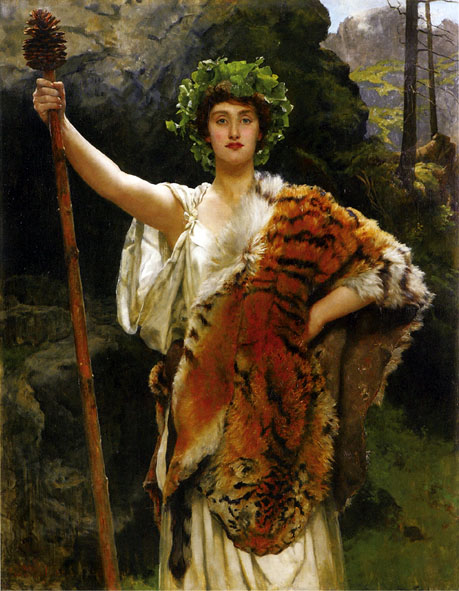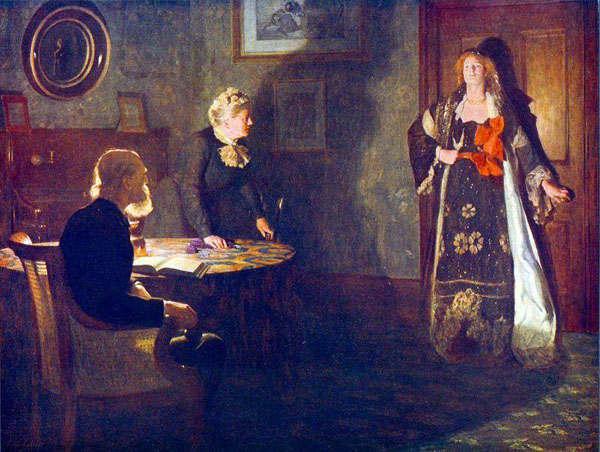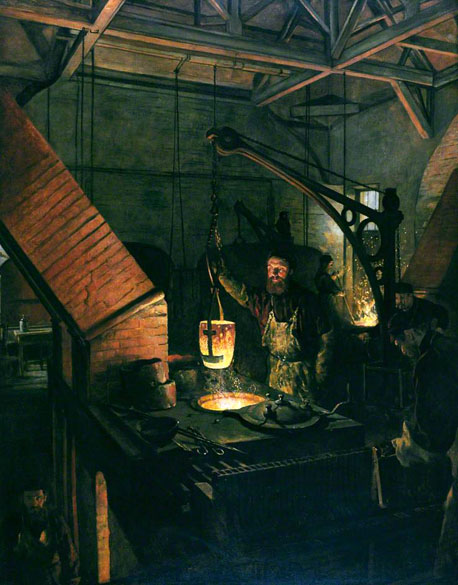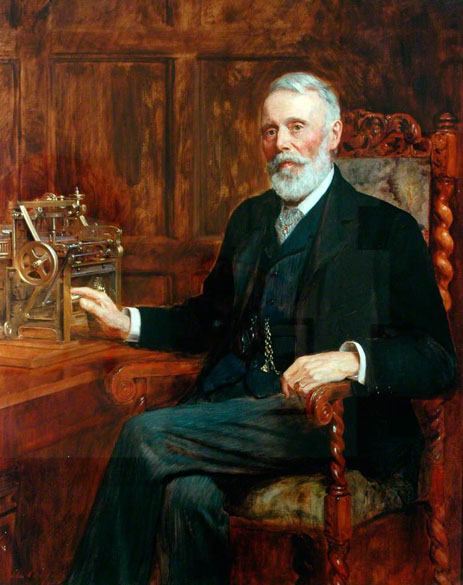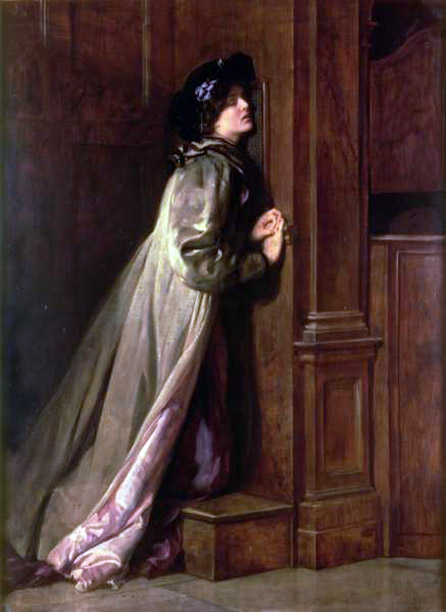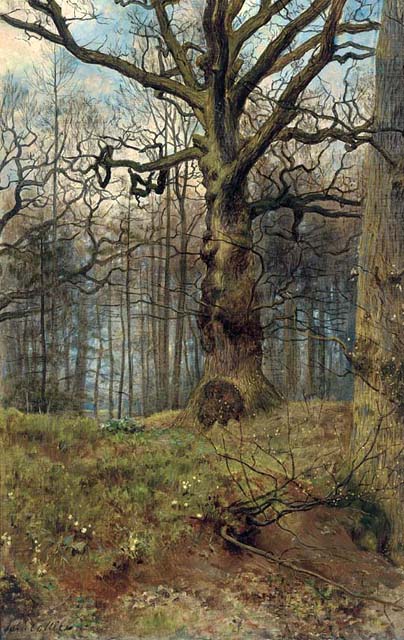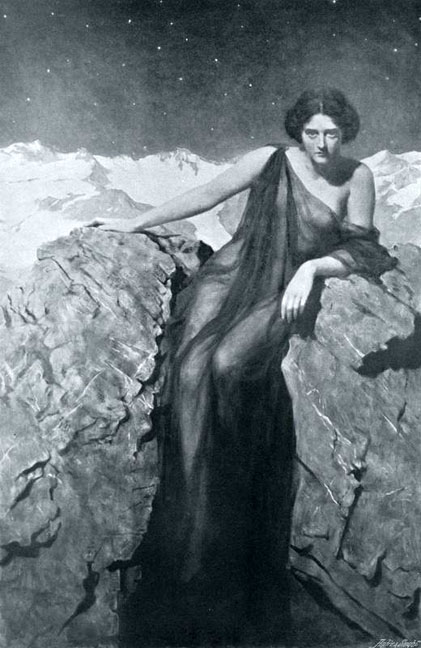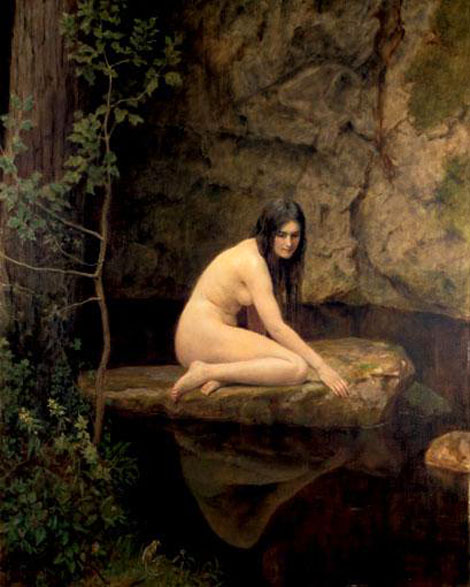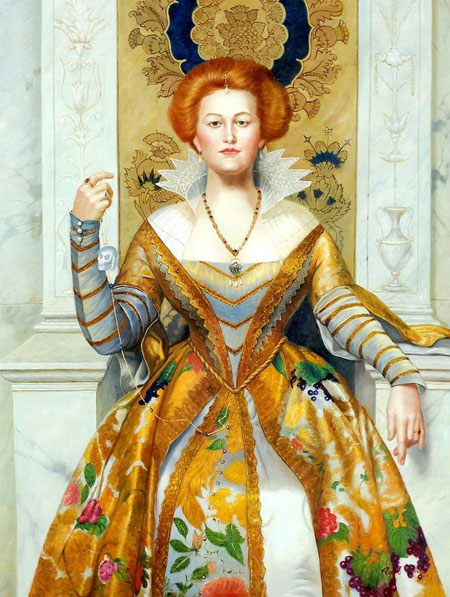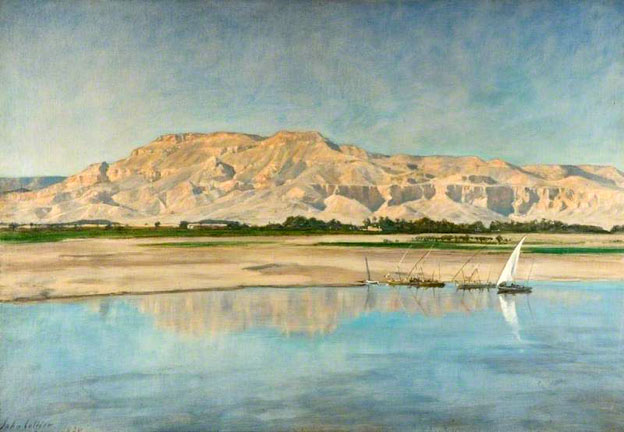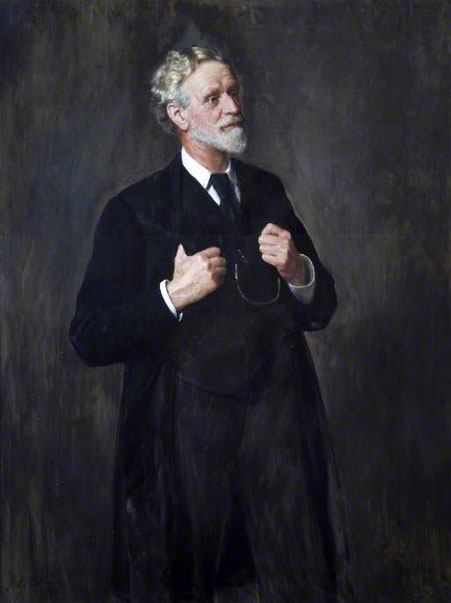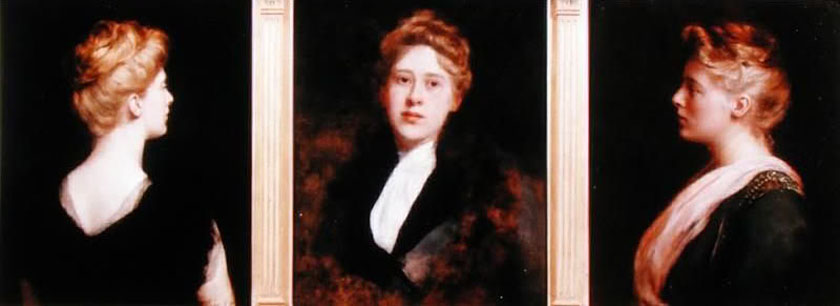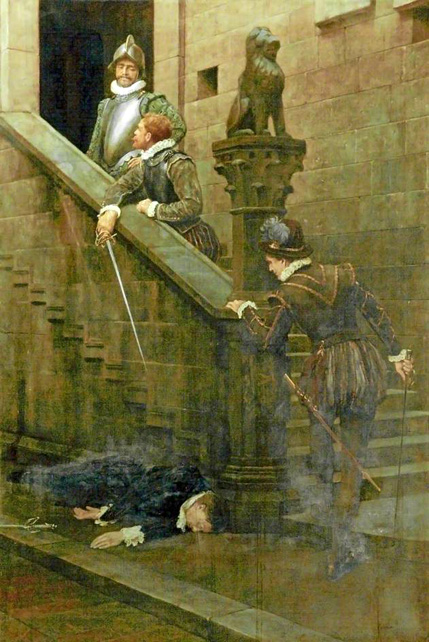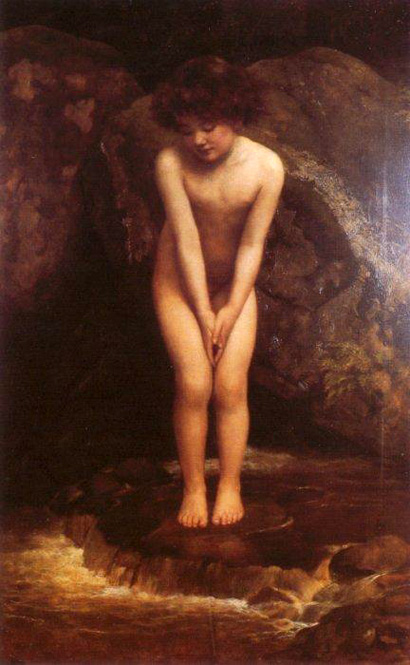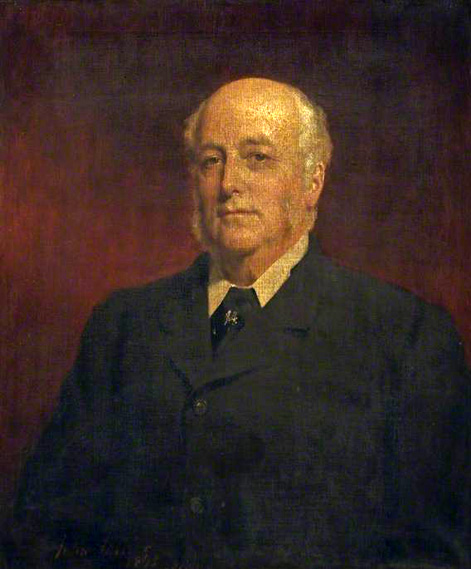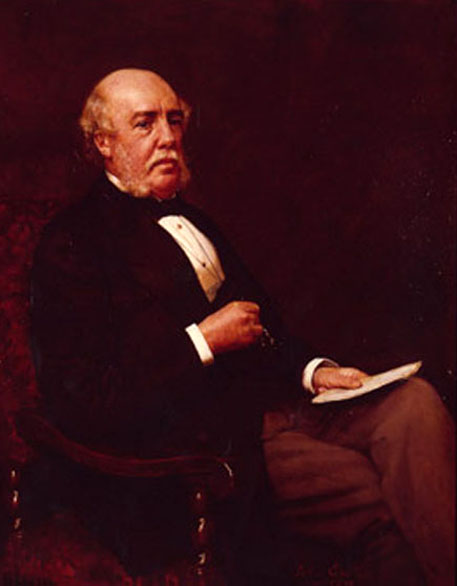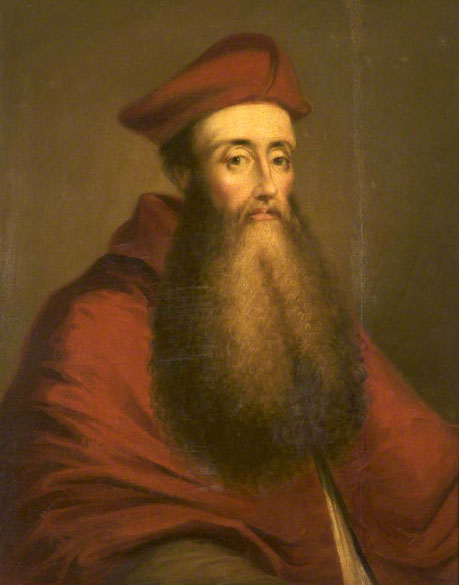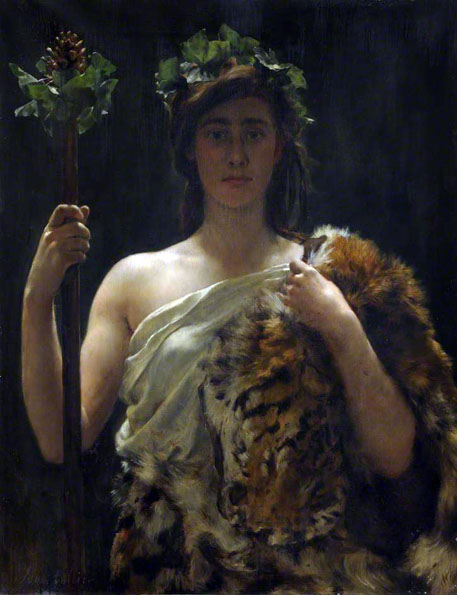Disclaimer
John Collier
English Classicist Painter
1850 - 1934
Portrait of John Collier by Marion Collier: ca 1882-83
The Honorable John Maler Collier was a leading English artist, and an author. He painted in the
Pre-Raphaelite style, and was one of the most prominent portrait painters of his generation. Both his marriages were to daughters of
Thomas Henry Huxley. He studied painting at the
Munich Academy where he enrolled on 14 April 1875 at the age of 25.
Collier was from a talented and successful family. His grandfather, John Collier, was a Quaker merchant who became a Member of Parliament. His father (who was a Member of Parliament, Attorney General and, for many years, a full-time judge of the Privy Council) was created the first
Lord Monkswell. He was also a member of the
Royal Society of British Artists. John Collier's elder brother, the second Lord Monkswell, was Under-Secretary of State for War and Chairman of the London County Council.
In due course, Collier became an integral part of the family of Thomas Henry Huxley PC, President of the Royal Society from 1883 to 1885. Collier married two of Huxley's daughters and was "on terms of intimate friendship" with his son, the writer
Leonard Huxley. Collier's first wife, in 1879, was Marian (Mady) Huxley. She was a painter who studied, like her husband, at the Slade and exhibited at the Royal Academy and elsewhere. After the birth of their only child, a daughter, she suffered severe post-natal depression and was taken to Paris for treatment where, however, she contracted pneumonia and died in 1887.
In 1889 Collier married Mady's younger sister Ethel Huxley. Until the
Deceased Wife's Sister's Marriage Act 1907 such a marriage was not possible in England, so the ceremony took place in Norway. Collier's daughter by his first marriage, Joyce, was a portrait miniaturist, and a member of the Royal Society of Miniature Painters. By his second wife he had a daughter and a son,
Sir Laurence Collier, who was the British Ambassador to Norway 1941-51.
Collier's range of portrait subjects was broad. In 1893, for example, his subjects included the Bishop of Shrewsbury (Sir Lovelace Stamer); Sir John Lubbock FRS; A N Hornby (Captain of the Lancashire Eleven); Sir Edward Augustus Inglefield (Admiral and Arctic explorer).
Sir Lovelace Stamer, Bishop of Shrewbury
Sir John Lubbock
A N Hornby: 1893
Sir Edward Augustus Inglefield: 1897
His commissioned portrait of the future King George V as Master of Trinity House in 1901 when Duke of York, and the Duke of Windsor when Prince of Wales were his major royal portraits. The latter work was hung in Durbar Hall, Jodhpur, Rajputana.
Other subjects included two Lord Chancellors (the Earl of Selborne in 1882 and the Earl of Halsbury) in 1897; The Speaker of the House of Commons, William Gully, (1897); senior legal figures the Lord Chief Justice Lord Alverstone (1912) and the Master of the Rolls Sir George Jessel (1881).
Rudyard Kipling (1891); the painter Sir Lawrence Alma-Tadema (1884); the actors J.L. Toole (1887) and Madge Kendal, Ellen Terry and Herbert Beerbohm Tree (in The Merry Wives of Windsor) (1904); heads of educational institutions such as the Master of Balliol Edward Caird (1904), the Warden of Wadham G.E. Thorley (1889) and the Provost of Eton (1897). He painted soldiers such as Field Marshal Lord Kitchener of Khartoum (1911) and Field Marshal Sir Frederick Haines (1891); two Indian maharajahs, including the Maharajah of Nepal (1910); and scientists including Charles Darwin (1882), the artist's father-in-law Professor Huxley (1891), William Kingdom Clifford, James Prescott Joule and Sir Michael Foster (1907). Clark reports a total of thirty-two Huxley family portraits during the half-century after his first marriage.
Rudyard Kipling: 1891
Ellen Terry as Lucy Ashton
The Merry Wives of Windsor Herbert Beerbohm Tree as
Falstaff with Ellen Terry and Mrs Kendal
Field Marshal Earl Kitchener of Khartoum: Date Unknown
Charles Robert Baldwin (Detail)
William Kingdom Clifford: 1899
James Prescott Joule: 1882
A photocopy of John Collier's Sitters Book (made in 1962 from the original in the possession of the artist's son) can be consulted in the National Portrait Gallery Heinz Archive and Library. This is the artist's own handwritten record of all his portraits, including name of subject, date, fee charged, and details of any major exhibitions of the picture in question.
Collier died in 1934. His entry in the Dictionary of National Biography (volume for 1931-40, published 1949) compares his work to that of Frank Holl because of its solemnity. This is only true, however, of his many portraits of distinguished old men - his portraits of younger men, women and children, and his so-called "problem pictures", covering scenes of ordinary life, are often very bright and fresh.
His entry in the Dictionary of Art, by Geoffrey Ashton, refers to the invisibility of his brush strokes as a "rather unexciting and flat use of paint" but contrasts that with "Collier's strong and surprising sense of colour" which "created a disconcerting verisimilitude in both mood and appearance".
The Dictionary of Portrait Painters in Britain up to 1920 (1997) describes his portraits as "painterly works with a fresh use of light and colour".
Sixteen of John Collier's paintings are now in the collections of the
National Portrait Gallery in London, and two are in the
Tate Gallery. Four of the National Portrait Gallery paintings are currently (December 1997) on display: John Burns, Sir William Huggins, Thomas Huxley (the artist's father in law) and Charles Darwin (copies of the last two are also prominently displayed at the top of the staircase at the
Athenaeum Club in London).
From the National Portrait Gallery
Anthony Ashley-Cooper, 7th Earl of Shaftesbury
Anthony Ashley Cooper, 7th Earl of Shaftesbury KG (1801 -1885), styled Lord Ashley from 1811 to 1851,
was an English politician, philanthropist and social reformer.
Charles Robert Darwin: 1883
Charles Robert Darwin, FRS (12 February 1809 - 19 April 1882) was an English naturalist and geologist, best known for his contributions to evolutionary theory. He established that all species of life have descended over time from common ancestors, and in a joint publication with Alfred Russell Wallace introduced his scientific theory that this branching pattern of evolution resulted from a process that he called natural selection, in which the struggle for existence has a similar effect to the artificial selection involved in selective breeding.
Marion Collier (née Huxley) ca 1882-83
Thomas Henry Huxley: 1883
Thomas Henry Huxley (1825 -1895) was an English biologist (comparative anatomist), known as "Darwin's Bulldog" for his advocacy of Charles Darwin's theory of evolution.
Huxley's famous 1860 debate with Samuel Wilberforce was a key moment in the wider acceptance of evolution, and in his own career. Huxley had been planning to leave Oxford on the previous day, but, after an encounter with Robert Chambers, the author of Vestiges, he changed his mind and decided to join the debate. Wilberforce was coached by Richard Owen, against whom Huxley also debated whether humans were closely related to apes.
Huxley was slow to accept some of Darwin's ideas, such as gradualism, and was undecided about natural selection, but despite this he was wholehearted in his public support of Darwin. He was instrumental in developing scientific education in Britain, and fought against the more extreme versions of religious tradition.
In 1869 Huxley coined the term 'agnostic' to describe his own views on theology, a term whose use has continued to the present day.
Sir George Williams: 1887
John Elliott Burns: 1889
John Elliot Burns (1858 - 1943) was an English trade unionist and politician of the late 19th and early 20th centuries, particularly associated with London politics. He was a socialist and then a Liberal Member of Parliament and Minister. He was anti-alcohol and a keen sportsman. After retiring from politics, he developed an expertise in London history and coined the phrase "The Thames is liquid history".
George Smith: 1901
Sir William Huggins: 1905
Sir William Huggins, (1824 - 1910) was an English astronomer best known for his pioneering work in astronomical spectroscopy.
Sir Michael Foster: 1907
Sir Michael Foster, (1836 - 1907) was an English physiologist. He was born in Huntingdon, Cambridgeshire and educated at University College School, London. After graduating in medicine in 1859, he began to practice in his native town, but in 1867 he returned to London as teacher of practical physiology at University College London, where two years afterwards he became professor. In 1870 he was appointed by Trinity College, Cambridge, to its praelectorship in physiology, and thirteen years later he became the first occupant of the newly created chair of physiology in the university, holding it till 1903. One of his most famous students at Cambridge was Charles Scott Sherrington who went on to win the Nobel Prize in 1932.
He excelled as a teacher and administrator, and had a very large share in the organization and development of the Cambridge biological school. From 1881 to 1903 he was one of the secretaries of the Royal Society, and in that capacity exercised a wide influence on the study of biology in Britain. In 1899 he was created K.C.B., and served as president of the British Association at its meeting at Dover.
In the 1900 General Election, he was elected to represent the University of London in parliament. Though returned as a Unionist, his political action was not to be dictated by party considerations, and he gravitated towards Liberalism; but he played no prominent part in parliament and at the election of 1906 was defeated.
Sir (Mary) Valentine Ignatius Chirol: 1909
From the Tate Gallery
The Last Voyage of Henry Hudson: 1881
In 1611, while on an expedition to find the North-West Passage, explorer Henry Hudson and his son were cast adrift by his mutinous crew. Their fate was unknown but raised the taboo of cannibalism. Collier hints at this by posing Hudson, eerily staring out at the viewer like Dante’s ‘Ugolino’ by Joshua Reynolds, 1773. Incarcerated with his sons, Ugolino eats them to survive, although the act is futile and all eventually die. Here the vast, Arctic landscape remains impassive to a terrifying human drama. Collier’s audience noted its relevance to ongoing Arctic explorations and the search for the North-West Passage.
July 2010
Mrs. Huxley: ca 1927-28
This portrait is both a remarkable technical performance and a deliberately backward-looking souvenir. Mrs Huxley, the widow of the biologist T.H.Huxley, was the artist's mother-in-law (twice over, as after the death of his first wife he married her sister). In 1905 he had painted Mrs Huxley's portrait as a gift on her eightieth birthday. In 1927, when he was himself seventy-seven, he painted a replica at the request of Henry Tonks, who gave it to the Tate Gallery. The painting is in the manner of Holbein, even to the fabric of the dress and the panelling in the background. Tonks was a teacher at the Slade School, and his pupils had once been the avant-garde of London.
September 2004
A 1907 self-portrait has been preserved in the Uffizi in Florence which presumably commissioned it as part of its celebrated collection of artists' self-portraits.
Clytemnestra: 1882
Clytemnestra: 1914
Sentence of Death: 1908
Sir Charles Tertius Mander: ca 1892-96
Reproductions of many others, from various collections, may be consulted in the John Collier box in the National Portrait Gallery Heinz Archive and Library, and a very good selection is published in The Art of the Honorable John Collier by W.H. Pollock (1914). His work was also included in the Great Victorian Pictures exhibition mounted by the Arts Council in 1978.
Collier's views on religion and ethics are interesting for their comparison with the views of Thomas and Julian Huxley, both of whom gave Romanes lectures on that subject. In The religion of an artist (1926) Collier explains "It [the book] is mostly concerned with ethics apart from religion... I am looking forward to a time when ethics will have taken the place of religion... My religion is really negative. [The benefits of religion] can be attained by other means which are less conducive to strife and which put less strain on upon the reasoning faculties." On secular morality: "My standard is frankly utilitarian. As far as morality is intuitive, I think it may be reduced to an inherent impulse of kindliness towards our fellow citizens." His views on ethics, then, were very close to the agnosticism of T.H. Huxley and the humanism of Julian Huxley.
On the idea of God: "People may claim without much exaggeration that the belief in God is universal. They omit to add that superstition, often of the most degraded kind, is just as universal." And "An omnipotent Deity who sentences even the vilest of his creatures to eternal torture is infinitely crueler than the cruelest man." And on the Church: "To me, as to most Englishmen, the triumph of Roman Catholicism would mean an unspeakable disaster to the cause of civilization." And on non-conformists: "They have a superstitious belief in the actual words of the Bible which is very dangerous".
Related Source Material:
Additional Works of John Collier
A View across Lake Como
A Devonshire Orchard
A Glass of Wine with Caesar Borgia: 1893
A Great Lady
A Street in Jeusalem
Alderman Sinclair: 1894
Alfred Salwey: 1892
An Incantation
Angela McInnes: 1914
Annunciation
This Annunciation is set in suburbia, but the symbolism is quite traditional. Mary is reading from Isaiah about the Virgin who conceives and bears a son. The lily represents her purity, and she is welcoming Saint Gabriel.
Artemis
There can be no better training in the discrimination of what is healthy and beautiful in men and women than a severe course of drawings from casts of antique [Greek] statues. (John Collier)
Blanche Parish, Lady Shuttleworth: 1884
Brigadier-General Charles Spragge
Brotherhood of Man: 1900
As a beginning student, an artist must first of all learn to represent faithfully any object that he has before him. The man who can do it is a painter; the man who cannot do it is not one. (John Collier)
Charles Bradlaugh: 1918-19
Charles Bradlaugh 1833 - 1891) was a political activist and one of the most famous English atheists of the 19th century. He founded the National Secular Society in 1866.
Charlrs Robert Darwin
Circe: 1855
Circe, daughter of the sun, was a sorceress best known for her ability to turn men into animals with her magic wand. The daughter of Perse and Helios, and whose daughter is Aega (goddess of the sun) she is remembered for her encounter with Odysseus and his men, and renowned for her knowledge of magic and poisonous herbs.
When Odysseus and his men landed in Aeaea, his crew later met with Circe and were turned into pigs. Circe's spells however had no effect on Odysseus who earlier was given an herb by Hermes to resist her power. Circe realizing she was powerless over him lifted the spell from the crew and welcomed them in her home. After about a year when Odysseus leaves she warns them of the sirens they will encounter on their journey. Circe and Odysseus also bore a child together named Telegonus who later ruled over the Tyrsenians.
Circe also has the powers for spiritual purification as she purifies the Argonauts for the murder of Apsyrtus.
Colonel Arthur Stuart Daniel, Chairman of Godstone Rural District Council
Colonel Sir George Dixon: 1911
Colonel Sir Henry Saint John Halford: 1896
Unfortunately, no rules can be given to guide him [the student] in [the] difficult question of harmony; he must try different combinations, and not be content until he gets something which he feels at once is beautiful. (John Collier)
Crucifixion with Saints
Der Schmetterling
Doris Allan, Lady Vernon
Edward George Percy Littleton: 1913
Edward Henry Palmer: 1884
Imagination is not antagonistic to knowledge. On the contrary, the highest imagination is that which can assimilate all kinds of knowledge and make use of it as a vantage ground from which to soar to higher things. (John Collier)
Egg Dance: 1903
An egg dance is a traditional Easter game in which eggs are laid on the ground or floor and the goal is to dance among them damaging as few as possible. The egg was a symbol of the rebirth of the earth in Pagan celebrations of spring and was adopted by early Christians as a symbol of the rebirth of man at Easter.
Another form of egg dancing was a springtime game depicted at the painting of Pieter Aertsen. The goal was to roll an egg out of a bowl while keeping within a circle drawn by chalk and then flip the bowl to cover the egg. This had to be done with the feet without touching the other objects placed on the floor.
An early reference to an egg dance was at the wedding of Margaret of Austria and Philibert of Savoy on Easter Monday of 1498. The event was described in an 1895 issue of The American Magazine as follows.
Eliza Lynn Linton
Eve: 1911
Felix Thornley Cobbold: 1897
Fire
Francis Dukinfield Astley: 1881
George Biddel Airy: 1883
Sir George Biddell Airy, (1801 - 1892) was an English mathematician and astronomer, Astronomer Royal from 1835 to 1881. His many achievements include work on planetary orbits, measuring the mean density of the Earth, a method of solution of two-dimensional problems in solid mechanics and, in his role as Astronomer Royal, establishing Greenwich as the location of the prime meridian. His reputation has been tarnished by allegations that, through his inaction, Britain lost the opportunity of priority in the discovery of Neptune.
There is a curious tendency in the human mind to imagine it sees a continuation of any line when it knows that the object is continuous, and this is a tendency against which the artist should be particularly on his guard. (John Collier)
George Warrington Stevens, War Correspondent: 1900
George Warrington Stevens, usually credited as G.W. Stevens, (1869 - 1900), was a British journalist and writer.
Stevens was born in Sydenham, and educated at the City of London School and Balliol College, Oxford. He was elected a fellow of Pembroke College, Oxford, in 1893 and also spent some time at Cambridge where he edited a weekly periodical.
As a journalist, he distinguished himself by his clearness of vision and vivid style, and was connected successively with the National Observer, the Pall Mall Gazette, and, from 1896, the Daily Mail.
He was the most famous war correspondent of his time, before being eclipsed by the daring escape of young Churchill from a Pretoria prison. Stevens utilized the articles which appeared in these and other publications in various books, such as Monologues of the Dead (1895), The Land of the Dollar (America) (1897), With the Conquering Turk (1897), With Kitchener to Khartoum, chronicling his attachment to British forces during the Mahdi's War in the Sudan, The Tragedy of Dreyfus and his posthumous From Cape Town to Ladysmith. He is also the author of In India, a series of articles on India published in 1899.
He was appointed by the Daily Mail as war correspondent to South Africa during the Second Boer War in 1899. Caught in the siege of Ladysmith, he kept up morale during the early months with his mordant witticisms appearing in Ladysmith Lyre (e.g. "a strange sideway out of Ladysmith" for death by disease or starvation). He died of enteric fever (now more commonly known as typhoid) on 15 January 1900, six weeks before the Natal Field Army of Redvers Buller relieved Ladysmith.
Gilbert Henry Barford, Mayor of Bedford: 1928
Gloucester Docks
Henry Butlin, Pioneer of Head and Neck Surgery: 1903
Henry Gee: 1918
A Manual of Oil Painting, 1890: Even when we have done our best to hasten the drying of our picture, it will certainly not be in a fit state to work on again until a clear day has elapsed. This is one of the serious inconveniences of oil painting; but it can be easily met by having two pictures going on on alternate days, which is not a bad thing in other ways, as the change of subject gives the eye a rest. (John Collier)
Herbert William Walmisley: 1912
Herbrand Arthur Russell: 1913
Hetty Sorrell
Hetty Sorrel is a major character in George Eliot's novel Adam Bede (1859).
Beautiful but thoughtless Hetty lives in the fictional community of Hayslope - a rural, pastoral and close-knit community in 1799. Her home is on Mr. Martin Poyser's dairy farm as she is his niece. Because she is an extremely pretty girl, she is admired by Mr. Craig and Adam Bede as well as Captain Arthur Donnithorne. Aside from her great physical beauty, George Eliot takes care to make it clear that she does not have many attractive personal qualities. She is spoiled, cold, insensitive, indifferent to other people's problems, and almost comically vain and selfish
Hetty is a cousin by marriage of Dinah Morris, a fervent Methodist lay preacher. In contrast to Hetty, Dinah is depicted as completely pure, generous, unselfish, modest, and unfailingly compassionate.
The novel revolves around a love triangle between vain and pleasure-loving Hetty Sorrel, Captain Arthur Donnithorne, the young squire who seduces her, Adam Bede, her unacknowledged lover, and Dinah Morris.
Adam is in love with Hetty. Though she is only a milkmaid, Hetty secretly longs for the luxurious life of an upper class lady. She is attracted to Captain Donnithorne and soon falls in love with him. When Adam interrupts a tryst between them, Adam and Arthur fight. Arthur leaves Hayslop to return to his militia. Broken-hearted, she agrees to marry Adam but shortly before their marriage, discovers she is pregnant, and having second thoughts, leaves in search of Arthur. She cannot find Arthur, and unwilling to return to the village and shame her family, she delivers her baby anonymously. She kills the child by abandoning it in a field, where it dies of exposure.
Hetty is caught and tried for child murder. She is found guilty and sentenced to hang. When Arthur Donnithorne, on leave from the militia for his grandfather's funeral, hears of her impending execution, he races to the court and has the sentence commuted to transportation.
According to the Oxford Companion to English Literature (1967),
"the plot (of Adam Bede) is founded on a story told to George Eliot by her aunt Elizabeth Evans, a Methodist preacher, and the original of Dinah Morris of the novel, of a confession of child-murder, made to her by a girl in prison."
Horace and Lydia: 1924
Horace and Lydia Reconciled by Eugene Field
HORACE
When you were mine in auld lang syne,
And when none else your charms might ogle,
I'll not deny,
Fair nymph, that I
Was happier than a Persian mogul.
LYDIA
Before she came--that rival flame!
(Was ever female creature sillier?)
In those good times,
Be praised in rhymes,
I was more famed than Mother Ilia!
HORACE
Chloe of Thrace! With what a grace
Does she at song or harp employ her!
I'd gladly die
If only I
Might live forever to enjoy her!
LYDIA
My Sybaris so noble is
That, by the gods! I love him madly
That I might save
Him from the grave
I'd give my life, and give it gladly!
HORACE
What if ma belle from favor fell,
And I made up my mind to shake her,
Would Lydia, then,
Come back again
And to her quondam flame betake her?
LYDIA
My other beau should surely go,
And you alone should find me gracious;
For no one slings
Such odes and things
As does the lauriger Horatius!
In the Forest of Arden: 1892
Believed to be derived from an Ancient British word ardu, meaning "high land", the area was formerly heavily forested and known as the Forest of Arden. Located in the geographical center of England, the Forest of Arden, through which no Roman roads were built, was bounded by the Roman roads Icknield Street, Watling Street, Fosse Way, and a prehistoric salt track leading from Droitwich. It encompassed an area corresponding to the north-western half of the traditional county of Warwickshire, stretching from Stratford-on-Avon in the south to Tamworth in the north, and included what are now the large cities of Birmingham and Coventry, in addition to areas that are still largely rural with numerous pockets of woodland. The most important and largest settlement in the forest was Henley-in-Arden, the site of an Iron Age hillfort.
An ancient mark stone known as "Coughton Cross" is still present at the south western corner of the forest, at the junction of Icknield Street and the salt track. It is located at the southern end of the frontage of Coughton Court and is owned by the National Trust. According to local tradition, travelers prayed here for safe passage through the forest.
Thorkell of Arden, a descendant of the ruling family of Mercia, was one of the few major English landowners who retained extensive properties after the Norman Conquest, and his descendants, the Arden family, remained prominent in the area for centuries. Mary Arden, mother of William Shakespeare, was a member.
Shakespeare's play As You Like It is set in the Forest of Arden, however it is an imaginary version incorporating elements from the Ardennes forest in Thomas Lodge's prose romance Rosalynde and the real forest (both as it was then, subjected to deforestation and enclosure, and the romanticized version of his youth).
From around 1162, until the suppression of the order in 1312, the Knights Templar owned a preceptory at Temple Balsall in the middle of the Forest of Arden. The property then passed to the Knights Hospitaller, who held it until the Reformation in the 16th century.
Robert Catesby, leader of the Gunpowder Plot of 1605, was a native of Lapworth, a village in Arden. It is believed that many local families had resisted the Reformation and retained Catholic sympathies, including the family of Shakespeare, whose paternal ancestors were from Temple Balsall.
Towns in the area include Hampton-in-Arden, Henley-in-Arden, and Tanworth-in-Arden.
In the Venusberg Tannhäuser: 1901
Tannhäuser (Middle High German: Tanhûser; died after 1265) was a German Minnesänger and poet. Historically, his biography is obscure beyond the poetry, which dates between 1245 and 1265. Socially, he presumed familial lineage with the old nobles, the Lords of Thannhausen, residents in their castle at Tannhausen, near Ellwangen and Dinkelsbühl; moreover, the historical Tannhausen castle, is at Neumarkt in der Oberpfalz.
Tannhäuser was an active courtier at the court of Frederick II of Austria (1230-1246), and the Codex Manesse (1340) depicts him clad in the Teutonic Order habit, suggesting he might have fought the Fifth Crusade (1213-21). As literature, Tannhäuser's poems parody the traditional genre, because he was a proponent of the leich (lai) style of poetry; however, the Bußlied (Poem on Atonement) is unusual, given the eroticism of the remaining Codex Manesse.
If the picture be of any size, a shed should be built in which the painter can stand whilst at work. The front and one side should be open to the view and to give plenty of light - the back facing toward the prevailing wind will be shelter enough. (John Collier)
James Andrew: 1894
James Laing: ca 1896
John Bland-Sutton
Sir John Bland-Sutton, 1st Baronet (1855 - 1936), was a British physician.
Bland-Sutton was President of the Royal Society of Medicine between 1920 and 1922 and of the Royal College of Surgeons of England in 1923. In 1925 he was created a Baronet, of Middlesex Hospital in the County of London. He died in December 1936 when the title became extinct.
Julia Neilson-Terry as Drusilla Ives in The Dancing Girl: 1891
Julia Neilson (1868 - 1957) was an English actress best known for her numerous performances as Lady Blakeney in The Scarlet Pimpernel, for her roles in many tragedies and historical romances, and for her portrayal of Rosalind in a long-running production of As You Like It.
After establishing her reputation in a series of plays by W. S. Gilbert in 1888, Neilson joined the company of Herbert Beerbohm Tree, where she remained for five years, meeting her future husband, Fred Terry (brother to actresses Kate, Ellen, Marion and Florence Terry and great uncle of John Gielgud). With Terry, she played in London and on tour for nearly three decades. She was the mother of actress Phyllis Neilson-Terry and actor Dennis Neilson-Terry.
Lady Darling: 1892
Lady Godiva: 1897
Lady Godiva was an 11th-century Anglo-Saxon noblewoman who, according to a legend dating back at least to the 13th century, rode naked through the streets of Coventry in order to gain a remission of the oppressive taxation imposed by her husband on his tenants. The name "Peeping Tom" for a voyeur originates from later versions of this legend in which a man named Tom had watched her ride and was struck blind or dead.
It matters not what kind of figure-pictures he [the artist] wishes to paint, he will never be able to draw the figure properly, whether draped or otherwise, unless he has gone through a preliminary course of study from the nude. (John Collier)
Lady Laing: 1893
Lady with a Bowl of Pink Carnations
Lewis Waller as Monsieur Beaucaire: 1903
William Waller Lewis (1860 - 1915), known on stage as Lewis Waller, was an English actor and theatre manager, well known on the London stage and in the English provinces.
After early stage experience with J. L. Toole's and Helena Modjeska's companies from 1883, Waller became known, by the late 1880s, for romantic leads, both in Shakespeare and in popular costume dramas of the Victorian and Edwardian eras. He attracted a large number of female admirers, who formed themselves into a vocal and conspicuous fan club. He also tried his hand at management of tours in 1885 and 1893 and then became an actor-manager at the Theatre Royal, Haymarket in the mid-1890s. After the turn of the century, he returned to management, and remained an actor-manager for the rest of his career, both in London and on tour.
Despite his commercial success in such parts as the title roles in Booth Tarkington's Monsieur Beaucaire and Arthur Conan Doyle's Brigadier Gerard, Waller greatly preferred acting in Shakespeare, in which his roles ranged from Romeo to Othello. Among the roles he created was Sir Robert Chiltern in Oscar Wilde's 1895 comedy An Ideal Husband.
Lieutenant Evan Davies Jones, Royal Flying Corps: 1918
Lilith: 1892
Lord Monkswell: 1904
Major General M. W. E. Gossett: 1906
Marion Collier née Huxley: 1882-83
The sitter married fellow artist John Collier in 1879 and this is the second of two recorded oil portraits by him, showing Marion as a fashionable young wife. In his Sitters Book, it is listed as 'Marion Collier, standing' under 1883 (as with the signature) and also as having been exhibited at the Grosvenor Gallery in 1882 (as indeed it was). This inconsistency suggests that the canvas was re-worked, an inference supported by the fact that the signature and the flowers, which overlie the dress, are later additions.
It seems likely that this work was painted while the artist was sitting to his wife for her large portrait of him, presumably at the start of that endeavor. Intriguingly, however, while Marion's portrait of John shows a reversed image on his easel which is similar in format to the present work, it depicts a left profile and ruffled lace collar. Was that Marion's invention or John's original concept for this portrait?
In 1884, the year after her portrait of John was shown at the Grosvenor, Marion Collier exhibited a portrait of her sister Nettie and a neoclassical subject picture of two undraped and semi-draped female figures entitled By the tide less, dolorous midland sea, which was apparently bought by Arthur Lewis. By this date, however, her psychological condition was grievous and in 1887 she was examined by the celebrated neurologist J.-M. Charcot, specialist in nervous hysteria, who arranged for treatment in Paris. With her husband and two nurses she travelled to France, but died suddenly, from pneumonia, on 19 November at Suresnes, probably in the psychiatric clinic established there by Valentin Magnan.
Her obituary reads:
We regret to announce the death of the Hon. Mrs. Collier, daughter of Professor Huxley and wife of the Hon. John Collier, the well-known artist. Mrs. Collier, who was only 27 years of age, died at Suresnes, somewhat suddenly, of inflammation of the lungs, on Friday night last. She herself had remarkable talent as an artist. Her first picture, "The Sins of the Fathers" was favorably placed at the RA in 1879 [sic]. She was also an exhibitor in 1881, showing, in addition to a subject picture, a full-length portrait of her sister Miss Nettie Huxley. In another year her picture "By the Tide less Midland Sea" was one of the chief attractions at the Grosvenor Gallery, where Mrs. Collier also exhibited some very charming child portraits.
The Honourable Mark George Kerr Rolle: 1907
Hon. Mark George Kerr Rolle (1835-1907) (born Mark George Kerr Trefusis) was High Sheriff of Devon in 1864, a DL of Devon and High Steward of Barnstaple. Due to an inheritance from his uncle, John Rolle, 1st Baron Rolle (1750-1842), he became the largest private landowner in Devon, according to the Return of Owners of Land, 1873. He was a prolific philanthropist and builder and restorer of churches, farms and cottages, the latter for his estate workers. His landholdings, of which he was life-tenant under his uncle's will, extended to 55,000 acres.
The Daughters of Col. Makins: 1884
Meditation: 1921
Montana, Canada
Moonlight
“I sometimes marvel that a third-rate writer like me has been able to palm himself off as a second-rate writer.”? John Collier
Mother of Pearl: 1932
Mrs Griffiths
Mrs Mortimer Collier and Family: 1880
Mrs Osborne
Myrrh, Alones and Cassia
Nettie and Joyce: ca 1890
The Pharaoh's Handmaidens: 1883
How is it possible to make an interesting picture out of a commonplace person in the costume of the present day ? It must be acknowledged that in some cases the problem is hopeless. There are some portraits which, at the best, can only be interesting to artists on account of their technical merits, but which to the general public must be simply ugly and dull.
~ John Collier
Pomps and Vanities: 1917
Collier's sumptuous depiction of grande luxe and sensuality marks a high-point in his varied oeuvre. Both Millais and Alma-Tadema took an interest in his early career, while his formal education was undertaken at the Slade, under Sir Edward Poynter, and in Paris under J.P. Laurens. He exhibited over 140 works at the Royal Academy; this picture appeared there in 1917. It prefigures the liberation found after the First World War, and is in marked contrast to The Sleeping Beauty, sold in these Rooms, 5 June 2008, lot 53, which can be considered one of the final manifestations of Pre-Raphaelitism.
Pope Urban VI: 1896
"This Picture illustrates an incident in the life of Pope Urban VI. This scene is related in Lea's "History of the Inquisition." Hearing of a conspiracy among his Cardinals, the Pope invited the ringleaders to his country residence, the Castle of Nocera, where he endeavored to extract from them the details of the conspiracy by torture. Urban VI walked to and fro in the garden beneath the window of the torture-chamber reciting his breviary aloud to encourage the torturers in their work."
Portrait of the Artist's Daughter: 1929
The bust in this painting is of Collier's father in-law, Thomas Henry Huxley (1825-1895). According to the Huxley File the bust was located at Hodeslea Hall, Staveley Road, Eastbourne and its creator was Sir Joseph Edgar Boehm (1834-1890).
Portrait of a Gentleman in his Library: 1890
Portrait of a Lady in Eastern Dress: 1890
Portrait of a Woman in Pink Dress
It ought, if possible, to be beautiful, and it ought to more or less explain itself; that is, one should be able to guess at the general nature of the incident without having recourse to an elaborate written explanation. ~ John Collier
Portrait of Colonel Rowland John Beech
Portrait of Edward Henry Hurry
Portrait of Field-marshall B. F. Haines: 1891
Field Marshal Sir Frederick Paul Haines (1819 - 1909) was a British army officer. After an education at Midhurst Grammar School and the Royal Military College, Sandhurst, Haines was commissioned into the 4th Regiment of Foot in 1839. Haines served in the Crimean War and as the senior officer at the Battle of Inkerman in 1854 held the barrier for six hours. In 1860 he was appointed Commanding Officer of the 8th Regiment of Foot back in the United Kingdom.
He went to India in 1865 and became General Officer Commanding the Mysore Division of the Madras Army. From 1870 to 1871 he was Quartermaster-General to the Forces before returning to India to be Commander-in-Chief of the Madras Army. He became Commander-in-Chief, India in 1876, a post he held until 1881, when he returned to the UK.
In 1880, Haines was offered a baronetcy for services to HM Government in India. He declined the honor due to his wife's failing health, presuming that it would be re-offered to him after her recovery. However, her health declined and she eventually died; the offer of the baronetcy was never renewed.
He was created a Field Marshal in 1890. Haines is buried in Brompton Cemetery, London.
Portrait of Laura Mary Stapleton: 1882
Portrait of Mary Frances Wilson
Portrait of Mrs Adeline Hurry
Portrait of Mrs H. C. Marillier
The art of painting in oils is a very difficult one, and not the least of its difficulties consists in the great uncertainty that exists as to the proper methods to be pursued. ~ John Collier
Portrait of Professor Huxley
Portrait of the 4th Earl of Onslow, Governor of New Zealand: 1903
William Hillier Onslow, 4th Earl of Onslow (1853 - 1911) was a British Conservative politician. He held several governmental positions between 1880 and 1905 and was also Governor of New Zealand between 1889 and 1892.
Portrait of Unknown Soldier: 1921
Priestess of Delphi: 1891
The Delphic Oracle was originally a shrine of the earth-goddess and the most famous of all oracles. The oracle of Apollo at Delphi was thought to be located at the center of the known world, and served as one of the few unifying elements for the fragmented Hellenic community.
The priestess sat symbolically; at the center of the world, in the sunken area at the end of the temple interior, on a tripod over cracks in the earth's crust which emitted sulphur fumes and enhanced her state of trance. She was considered the mouthpiece of the Olympian gods and spent one month each year accepting visitors and answering their questions.
The rich and powerful throughout Greece and the Mediterranean world came to her for advice, leaving valuable treasures as payment for the priestess' words of wisdom and prophesy.
Queen Guinevre's Maying
Guinevere was the legendary Queen consort of King Arthur. In tales and folklore, she was said to have had a love affair with Arthur's chief knight Sir Lancelot. This story first appears in Chrétien de Troyes' Lancelot, the Knight of the Cart, and reappears as a common motif in numerous cyclical Arthurian literature, starting with the Lancelot-Grail Cycle of the early 13th century and carrying through the Post-Vulgate Cycle and Thomas Malory's Le Morte d'Arthur. Guinevere and Lancelot's betrayal of Arthur was often considered as having led to the downfall of the kingdom.
Reclining Woman
Richard Hill Dawe, Solicitor to the Great Northern Railway: 1923
Sacred and Profane Love: 1919
Saint Paul
Saint Peter
Samuel Radcliffe Platt, Mayor of Oldham
Samuel Whitbread
Self Portrait
Sir Andrew Mitchell Torrance: 1912
Andrew Mitchell Torrance (1845 - 1909) was a British Liberal Party politician. He was born in Old Cumnock, East Ayrshire in 1845. He was educated at Cumnock parish school. In 1861 he was apprenticed to Peter Kelso and Co., muslin manufacturers of Glasgow. In 1863, moving to London, he worked for Smith, Anderson and Co. In 1875 he became a partner and the firm changed its name to Miller, Son, and Torrance.
He was elected to the London County Council as a Liberal backed Progressive Party member representing Islington East. He was re-elected on every occasion until standing down in 1907. He was Deputy Chairman of the London County Council in 1897-98 and again in 1900-01 and served as Chairman in 1901-02. He was also involved in Islington Borough municipal politics, being elected to the Council and serving as Mayor of Islington from 1903-05. In June 1903, he was appointed a Deputy Lieutenant of the County of London.
He first stood for parliament in 1900 as a Liberal candidate in his London County Council seat in Islington, but was unsuccessful. He was given a knighthood in 1906. He died in February 1909.
Sir Charles Hall, Recorder of London: 1895
Sir Charles Hall (1843 - 1900) was a British lawyer and politician. He was the second son of Sir Charles Hall (1814-1883) and his wife, Sarah née Duval. After attending Harrow School, he studied at Trinity College, Cambridge, and under James Hannen, Baron Hannen at Lincoln's Inn.
He was called to the bar on 17 November 1866, and built up a large practice in the Admiralty court and the south-east of England, becoming a Queen's Counsel in 1881.
From 1877 until his appointment as recorder of London in 1892, he was attorney-general to the Prince of Wales. In May 1890, he was made a Knight Commander of the Order of St Michael and St George for acting as the British representative at an international conference on maritime law held in Washington, D.C., the previous year.
In the United Kingdom general election, 1885 he was returned as Conservative Member of Parliament for the Chesterton division of Cambridgeshire. After his defeat in the 1892 general election, he was elected at a by-election in August 1892 for the Holborn division of Finsbury. He was appointed as a Privy Councillor in 1899, and died in office in March 1900. He never married, and is buried in Kensal Green Cemetery.
Sir Charles Strickland: 1904
Sir Charles William Strickland, 8th Baronet (1819 - 1909) was an English barrister and a rower who was in the winning crew in the first Grand Challenge Cup at Henley Royal Regatta. He was President of the Yorkshire Philosophical Society.
Strickland was born and died at Hildenley Hall, near Malton, Yorkshire. He was the eldest son of Sir George Strickland, 7th Baronet, of Boynton. He was educated at Rugby School where he is supposed to have been the original of the character 'Martin' in Tom Brown's Schooldays. He was admitted to Trinity College, Cambridge on 6 March 1837 and was also admitted at Lincoln's Inn on 11 March 1841.
Strickland married Georgina Selina Septima Milner, daughter of Sir William Mordaunt Sturt Milner, but on 19 September 1850 and they had a son Walter. He married secondly on 22 May 1866, Anne Elizabeth Nevile, daughter of Rev. Christopher Nevile, of Thorney, Nottinghamshire. They had a son Henry and a daughter.
He rowed for Trinity College in the crew which won the first Grand Challenge Cup at Henley Royal Regatta in 1839. Strickland was called to the bar on 6 May 1847 and was also admitted at the Middle Temple on 6 February 1849.
Strickland was on the Northern Circuit and was chairman of the East Riding of Yorkshire Quarter Sessions. He succeeded his father in the baronetcy on 23 December 1874. He was High Sheriff of Yorkshire in 1880.
Sir Edwin Cornwall: 1907
Sir Edwin Andrew Cornwall, 1st Baronet, PC, DL (1863 - 1953) was an English politician and coal merchant.
Cornwall was born in Lapford, Devon. At the age of thirteen he became a clerk in a coal merchant's in Hammersmith, London, and by seventeen was manager of the company's depot at Kensington. A few years later he set up his own business. In 1900 he became the first mayor of the new Metropolitan Borough of Fulham, having long served on the predecessor vestry. In 1892 he was elected to the London County Council, sitting for the Progressive Party, for which he was for eight years chief whip. In 1904 he was elected chairman of the LCC and as chairman of the Parliamentary Committee of the council led efforts to clear the slums between Holborn and the Strand on the site of which were built Aldwych and Kingsway.
Having unsuccessfully contested the Fulham constituency in 1895 and 1900, in 1906 Cornwall was elected to Parliament as a Liberal for Bethnal Green North East. He was appointed a deputy lieutenant of the County of London at the end of March 1906. From December 1916 to February 1919 he served as Minister of National Health Insurance and Comptroller of the Household and from 1918 to 1922 he was Deputy Chairman of Ways and Means and Deputy Speaker of the House of Commons. He was also vice-chairman of the County of London Territorial Force Association from 1908 to 1914 and a member of the Port of London Authority.
Cornwall was knighted in 1905, created a baronet in 1918, and appointed to the Privy Council in the 1921 Birthday Honors, entitling him to the style "The Right Honorable".
Sir Francis Layland-Barratt
Sir Francis Layland-Barratt (1860 - 1933) was a British Liberal Party politician. He was born in 1860, the first son of Francis Barratt of St Austell, Cornwall. He was educated at Trinity Hall, Cambridge (MA, LLB). He married in 1884, Frances Layland (Lady of Grace of the Order of St John of Jerusalem, CBE 1920) of Stonehouse, Wallasey. They had one son and three daughters. He assumed the additional surname of Layland by Royal Licence in 1895.
He contested the Torquay Division of Devon at the General Election of 1895, for the Liberal Party, but was unable to take the seat from the Conservative. He served as High Sheriff of Cornwall from 1897 to 1898. He contested Torquay for the Liberals again at the 1900 General Election and this time was successful, gaining the seat from the Conservative. He served as Liberal MP for Torquay from 1900 to 1910. He served as a Justice of the Peace in Devon and Cornwall. He was appointed Deputy Lieutenant for Cornwall. He was reelected at the 1906 General Election. On 23 July 1908 he was created a Baronet. He was re-elected at the General Election of January 1910 with a majority of just 11 votes. He lost his seat at the General Election of December 1910 to a Liberal Unionist. In 1915, the Liberal MP for St Austell Division of Cornwall was killed in action. Barrett was chosen as Liberal candidate to replace him and due to the wartime electoral truce, did not face a Unionist opponent and was elected. He served as Liberal MP for St Austell from 1915 to 1918. He retired from parliament in 1918 when his constituency was abolished and did not contest any further General Elections. He continued to support the Liberal Party, at a local level in Torquay, he was the party's main patron. He served as Treasurer for the National Liberal Federation from 1927 until his death. He died on 12 September 1933 at the age of 73. His baronetcy then passed to his son Francis Henry Godolphin Layland-Barratt.
Sir Frederick George Banbury
Frederick George Banbury, 1st Baron Banbury of Southam (1850 - 1936), known as Sir Frederick Banbury, 1st Baronet, from 1903 to 1924, was a British businessman and Conservative Member of Parliament.
Banbury was the eldest son of Frederick Banbury and Cecilia Laura (née Cox) of Shirley House Surrey., and was educated at Winchester College. He was admitted to the London Stock Exchange in 1872 and was head of Frederick Banbury and Sons, stockbrokers, of London, between 1879 and 1906, as well as chairman of the Great Northern Railway (GNR) and a director of the London and Provincial Bank.
Banbury was elected to represent Camberwell, Peckham in the House of Commons at the 1892 general election, and held the seat in 1895 and 1900. At the 1906 general election he lost the seat as the Liberal Party won a large majority. Later in the year he returned to parliament when he was returned unopposed in a by election for the City of London. He held the seat until 1924.
He was a diligent member of the Commons, and was known for his formal attire and punctuality. Although he remained on the back benches he was regarded as an institution in the House. Banbury was created a baronet, "of Southam in the County of Warwick", in 1903, and admitted to the Privy Council in 1916.
After his retirement from the House of Commons in 1924 he was raised to the peerage as Baron Banbury of Southam, of Southam in the County of Warwick.
He was the last chairman of the GNR, which lost its identity when, under the Railways Act 1921, it was grouped with several other railways on 1 January 1923 to become a constituent of the London and North Eastern Railway (LNER). Sir Frederick was a strong opponent of the railway grouping, and had voted against the Bill during its passage through Parliament; he wanted no part of the future LNER, and decided to retire from railway service at the end of 1922. In late September 1922, the GNR honored Sir Frederick by naming its newest express passenger locomotive no. 1471 Sir Frederick Banbury. This locomotive belonged to GNR Class A1, was built in July 1922 and remained in service until November 1961.
Banbury was also an animal lover, and was for years on the council of the Royal Society for the Prevention of Cruelty to Animals, and served as its chairman.
Banbury married Elizabeth Rosa, daughter of Thomas Barbot Beale, of Brettenham, Suffolk in 1873. She died in 1930. Banbury survived her by six years and died in August 1936 at his home, Warneford Place, Highworth, Wiltshire aged 85. He was buried in Sevenhampton. He was succeeded in the barony by his grandson Charles, his only son Captain Charles William Banbury having been killed in the First World War.
Sir George Campbell
Sir George Campbell (1824 - 1892) was a Scottish Liberal Party politician and Indian administrator. Campbell was born in 1824, the eldest son of Sir George Campbell, of Edenwood, whose brother became the 1st Baron Campbell. He was educated at Hamilton Academy and embarked for India.
From 1871 to 1874 he was Lieutenant-Governor of Bengal. During his tenure the Pabna Disturbances occurred. With his proclamation on 4 July 1873 during the Pabna Peasant Uprisings, guaranteeing government support of peasants against excessive zamindar demands he ensured that the protest remained peaceful, at the same time antagonizing the landlords and his namesake George Campbell, 8th Duke of Argyll at that time Secretary of State for India.
He was Member of Parliament (MP) for Kirkcaldy Burghs from 1875 to 1892.
Campbell married, in 1853, Laetitia Maria Vibart, daughter of John Gowan Vibart, of the Bengal civil service, and left several children. Lady Campbell died in London 21 October 1901, aged 68.
Sir Isaac Wilson: 1893
Sir John Bland-Sutton: 1911
Sir John Bland-Sutton, 1st Baronet (1855 - 1936), was a British physician. Bland-Sutton was President of the Royal Society of Medicine between 1920 and 1922 and of the Royal College of Surgeons of England in 1923. In 1925 he was created a Baronet, of Middlesex Hospital in the County of London. He died in December 1936 when the title became extinct.
Sir John Evans: 1905
Sir John Evans (1823 - 1908) was an English archaeologist and geologist. John Evans was the son of the Rev. Dr. A. B. Evans, headmaster of Market Bosworth Grammar School, and was born at Britwell Court, Buckinghamshire. He was for many years manager of the extensive paper manufactory of his uncle, and later father-in-law, John Dickinson (1782-1869) at Nash Mills, Hemel Hempstead, but was distinguished especially as an antiquary, archaeologist and numismatist, that is, a collector of ancient objects and coins.
Evans was president from 1885 to 1892 of the Society of Antiquaries; and he was President of the Numismatic Society from 1874 to the time of his death. He was also president of the Geological Society of London, 1874-1876; the Anthropological Institute of Great Britain and Ireland, 1877-1879; the Society of Chemical Industry, 1891-1893; and the British Association for the Advancement of Science, 1897-1898. He was elected a Fellow of the Royal Society in 1864 and for twenty years (1878-1898) he was treasurer of the Royal Society. He was appointed High Sheriff of Hertfordshire for 1881.
As President of the Society of Antiquaries he was an ex officio trustee of the British Museum, and subsequently he became a permanent trustee. His academic honors included honorary degrees from several universities, and he was a corresponding member of the Institut de France. He was created a KCB (Knight of the Order of the Bath) in 1892. Most of his very large personal archaeological collection was given to the Ashmolean Museum in Oxford by his son Arthur. The Anglo-Saxon jewelled "Ixworth Cross" and "Tostock Buckle" are two of the outstanding objects. His library was left to the Bodleian Library. He died at Berkhamsted in 1908.
Sir Landon Ronald, Principal of the Guildhall School of Music
Sir Landon Ronald (born Landon Ronald Russell) (1873 - 1938) was an English conductor, composer, pianist, teacher and administrator.
In his early career he gained work as an accompanist and répétiteur, but struggled to make his way as a conductor. In the absence of operatic or symphonic work he made his living as a conductor and composer in West End shows in the late 19th and early 20th century. With the foundation of the London Symphony Orchestra in 1904 his career began to flourish, and by 1908 he was well-enough established to be chosen to succeed Thomas Beecham as conductor of the New Symphony Orchestra in London.
Ronald was an early enthusiast for recording, and was associated with the company eventually known as His Master's Voice from 1900 for the rest of his life. He composed throughout his career, and had many modest successes with his works.
From 1910 until shortly before his death, Ronald was principal of the Guildhall School of Music in London. He modernized the curriculum and raised its standards to compete with the leading musical training establishments the Royal Academy of Music and the Royal College of Music.
Sir Samuel Butler Provis: 1910
Sir Ughtred Kay-Shuttleworth: 1884
Ughtred James Kay-Shuttleworth, 1st Baron Shuttleworth PC (1844 - 1939), known as Sir Ughtred Kay-Shuttleworth, but, between 1872 and 1902, was a British landowner and Liberal politician. He was Under-Secretary of State for India and Chancellor of the Duchy of Lancaster under William Ewart Gladstone in 1886 and Parliamentary and Financial Secretary to the Admiralty under Gladstone and Lord Rosebery between 1892 and 1895.
Shuttleworth was the son of the physician, civil servant and social reformer Sir James Kay-Shuttleworth, 1st Baronet, the member of a nonconformist Midlands family of somewhat limited means. His father, born James Kay, had assumed the additional surname of Shuttleworth on his marriage to Janet Shuttleworth, only child and heiress of Robert Shuttleworth, of Gawthorpe Hall in Padiham, Lancashire. His father's brothers included the economist Joseph Kay and the Lord Justice of Appeal Sir Edward Kay.
The Shuttleworth family had been landowners in Lancashire from medieval times. Tradition states they made their fortune from wool weaving. They supported the parliamentary side in the English Civil War. Sir James and Lady Shuttleworth parted company after five children and Shuttleworth was raised largely apart from his father. For some years in his youth he lived in Germany with his mother. On her death, in 1872, he inherited large estates, including Gawthorpe Hall. His father then relocated to another of the estates, in Westmorland.
Shuttleworth was returned to parliament for Hastings in 1869, a seat he held until 1880. He remained out of parliament until 1885, when he was elected for the Clitheroe division of Lancashire, a constituency he continued to represent until his elevation to the peerage in 1902. When the Liberals came to power under William Ewart Gladstone in February 1886, Shuttleworth was made Under-Secretary of State for India. Already in April he became Chancellor of the Duchy of Lancaster, replacing Edward Heneage, who had resigned over Irish Home Rule. He was sworn of the Privy Council at the same time. He remained Chancellor of the Duchy of Lancaster until the Liberals fell from power in July 1886.
Shuttleworth returned to office under Gladstone in 1892 when he was made Parliamentary and Financial Secretary to the Admiralty, a post he held until 1895, the last year under the premiership of Lord Rosebery. In 1902 he was raised to the peerage as Baron Shuttleworth, of Gawthorpe in the County Palatine of Lancaster. From 1908 to 1928 he was Lord Lieutenant of Lancashire, in which capacity in 1910 he entertained King George V and Queen Mary at Gawthorpe Hall.
Lord Shuttleworth married Blanche Marion, daughter of Sir Woodbine Parish, in 1871. They had two sons and four daughters. Both his sons, Captain the Hon. Lawrence Ughtred Kay-Shuttleworth (1887-1917) and T/Captain the Hon. Edward James Kay-Shuttleworth (1890-1917) were killed in the First World War. Lady Shuttleworth died in June 1924. Lord Shuttleworth survived her by fifteen years and died in December 1939, aged 95. He was succeeded in his titles by his grandson, Richard, the eldest son of the Hon. Lawrence Kay-Shuttleworth. Richard was killed during the Battle of Britain only eight months later, when his Hawker Hurricane went missing during a battle over a Channel convoy, south of the Isle of Wight. His younger brother, Ronald, the third Baron, was killed in North Africa in 1942. The barony passed to Ronald's first cousin, Charles, the fourth Baron Shuttleworth. He was badly injured in the Second World War, losing one leg and the use of the other. He moved to another home, Leck Hall at Leck, Lancashire, on his estates, which was more convenient to his disability, leaving Gawthorpe Hall to his aunt, Rachel, who lived on at Gawthorpe Hall until her death in 1967. The estate became a National Trust property in 1970.
Sir William Mitchell Banks
Sir William Rose
Sir William Rose, 2nd Baronet (1846 - 1902) was a Scots-Quebecer barrister and heir to the Rose baronetcy, of Montreal upon the death of his father Sir John Rose, 1st Baronet in 1888. In 1869 Sir John moved to London, and William Rose spent most of his life in London. His chief fame is perhaps as owner of Moor Park, Farnham during the late Victorian era.
In 1846 William Rose was born in Montreal as the first son of John Rose, who held various high offices in Canada. In 1872 John Rose was created 1st Baronet Rose, of Montreal. William Rose inherited the title in 1888. In 1909 William's younger brother Sir Charles Day Rose was created 1st Baronet Rose of Hardwick House in his own right. William Rose was educated at Rugby College. In 1868 he married Katherine Elizabeth, daughter of Alexander Macalister, Torresdaile Castle, Argyllshire. Cyril Stanley Rose, the heir to Sir William's title, was born to the couple in 1874. Sir William was appointed Clerk of the Parliaments from 1875-1885. He was a business partner in the stock brokerage Govett, Sons, and Co.
Sir Willoughby Heyett Dickinson: 1902
Willoughby Hyett Dickinson, 1st Baron Dickinson (1859 - 1943), was a British Liberal Party politician.
Dickinson was the son of Sebastian Stewart Dickinson, Member of Parliament for Stroud. He was educated at Eton College and Trinity College, Cambridge. He was Member of Parliament for St. Pancras North from 1906 to 1918 and was an assiduous supporter of women's suffrage, promoting a number of measures in Parliament to get the vote for women. Dickinson was made a Privy Counselor in 1914 and in 1930 he was raised to the peerage as Baron Dickinson, of Painswick in the County of Gloucester.
He was later secretary-general of the World Alliance for International Friendship, and from 1931 chairman of its International Council.
He married Elizabeth, daughter of General Sir Richard John Meade, in 1891. They had three children, one of whom was Frances Joan Dickinson, Baroness Northchurch. Lord Dickinson died in May 1943, aged 84, and was succeeded in the barony by his grandson Richard, his only son the Hon. Richard Sebastian Willoughby Dickinson having predeceased him.
The Sleeping Beauty: 1921
Spring
Stepping Stones: Pamela: 1929
The Amber Necklace: 1930
The Artist's Wife: 1880
The Beggar Man: 1930
The Child Bride: 1883
The Confession: 1902
The Connoisseur, Reginald Barrett
The Death of Albine: 1895
The Death of Cleopatra
This huge painting (sized 12 feet 11.5 inches height x 10 feet wide) shows the final seconds of Cleopatra and her maids as described by Plutarch ('Lives' 44:86) and later dramatized by Shakespeare in 'Antony and Cleopatra'.
Today it is in the collection of Oldham Art Gallery. According to the curator's descriptive notes, the painting suffered water damage when it was shipped back from Chicago in 1893, it had been exhibited in the British Fine Art Section of the famous Chicago Exhibition. In 1914 it was damaged again when a visitor, perhaps a suffragette, deliberately slashed the canvas. During the Second World War it was put into storage, and it lay forgotten for forty years until the gallery restored it and put it back on public display.
The Garden of Armida
The story of Armida, a Saracen sorceress and Rinaldo, a soldier in the First Crusade, was created by the Italian poet Torquato Tasso. In his epic Gerusalemme liberata, Rinaldo is a fierce and determined warrior who is also honorable and handsome. Armida has been sent to stop the Christians from completing their mission and is about to murder the sleeping soldier, but instead she falls in love. She creates an enchanted garden where she holds him a lovesick prisoner. Eventually two of his fellow Crusaders find him and hold a shield to his face, so he can see his image and remember who he is. Rinaldo barely can resist Armida's pleadings, but his comrades insist that he return to his Christian duties.
Many painters and composers were inspired by Tasso's tale. The works that resulted often added or subtracted an element; Tasso himself continued to edit the story for years. In some versions, Armida is converted to Christianity, in others, she rages and destroys her own enchanted garden. She occupies a place in the literature of abandoned women such as the tragic Dido, who committed suicide, and the evil Circe, whom Odysseus abandoned to complete his voyage, but she is considered by many to be more human, and thus more compelling and sympathetic, than either of them.
The Honourable Florence Rachel Hamilton-Russell: 1901
The Laboratory
The Land Baby: 1899
The Maenads
In Greek mythology, Maenads were female worshippers of Dionysus, the Greek god of mystery, wine and intoxication. The word literally translates as "raving ones". They were known as wild, insane women who could not be reasoned with. The mysteries of Dionysus inspired the women to ecstatic frenzy; they indulged in copious amounts of violence, bloodletting, sex and self-intoxication and mutilation. They were usually pictured as crowned with vine leaves, clothed in fawn-skins and carrying the thyrsus, and dancing with the wild abandonment of complete union with primeval nature.
The Minx
The Plague: 1902
The Priestess of Bacchus: 1885-89
The Prodigal Daughter: 1903
The Queen's Shilling
The Right Honourable Samuel Cunliffe Lister: 1901
The Right Honourable T. F. Halsey: 1907
The Sinner: 1904
The Spring Wood
The Summer Night that Paused among her Stars: 1910
The Three Daughters of William Reed: 1886
The Water Nymph: 1923
The White Devil: 1909
Theban Hills from Luxor: 1920
Thomas Smith, Surgeon to St Bartholomew's Hospital: 1901
Triple Portrait of a Woman
Truth
Vendetta: 1915
Water Baby: 1890
William Charles Lucy: 1895
William Fred Collier
William Herford Ancrum, Esq: ca 1880
William Nicholson
Young Girl Draped in a Tiger Skin
This page is the work of Senex Magister
Return to Pagina Artis
Return to Bruce and Bobbie's Main Page.


